Opening Doors: How Selective Colleges and Universities Are Expanding Access for High-Achieving, Low-Income Students
Foreword
For generations, higher education was the great equalizer in society and a pillar of the American
dream: the college degree was the ladder into good jobs and the middle class for students from lower-income
families.
But that dream is no longer a reality for growing numbers of financially needy students. Whether
someone goes to college and— more important—whether that person graduates, is dependent almost
entirely on family income. What’s more worrisome for the future is that students in the pipeline to
college are needier than ever before. The poverty rate in the United States worsens as you move down
the age scale. Today, in 21 states, more than half of the children enrolled in K-12 schools come from
families making less than $40,000 a year, according to the Southern Education Foundation.
The jobs of the future increasingly require some sort of postsecondary education. If we as a nation
have any hope that the next generation will be better educated than today’s workforce, we must ensure
that access to a college education and completion of a degree is an opportunity based on talent, and
not income. That will require higher education institutions to consider new approaches to admissions
and financial aid and make tradeoffs many institutions have been unwilling to make up to this point.
For too many institutions, the last two decades have been about following an enrollment management
playbook that called for discounting tuition for high-caliber students, whether they needed the money
or not. It meant following the herd in higher education and adding amenities and new academic
programs at a breakneck pace, all in an effort to boost revenue, enrollment, and ultimately, rankings.
Plenty of institutions strayed from that pack and found success in recruiting and retaining low-income
students. Their stories are outlined in this report from the Jack Kent Cooke Foundation, which lays
out a road map for institutional leaders everywhere to follow in order to expand opportunities for
outstanding low-income students.
The demographics of the nation demand that colleges and universities think differently about how to
recruit classes and how to help students afford a college degree. This report is a very excellent start.
Jeffrey J. Selingo
Author, There Is Life After College
Founding Director, the Arizona State/Georgetown University
Academy for Innovative Higher Education Leadership
Introduction
Today a college degree is the ticket to a good job and the gateway to economic advancement. A student’s chances of gaining admission to college, however, are often based more on parental wealth than the student’s achievements. This is true at all levels of America’s higher education institutions.
Sadly, even our nation’s most academically able students have difficulty being admitted to the most selective institutions. This undeniable fact undermines the proposition that our higher education system is a meritocracy at its core. At our nation’s most selective colleges*, a mere three percent of incoming freshmen come from families in the bottom income quartile, while 72 percent come from families in the wealthiest quartile. As a result, there are 24 wealthy students for each low-income student at these elite schools. As documented in the 2016 Cooke Foundation report, “True Merit: Ensuring Our Brightest Students Have Access to Our Best Colleges and Universities,” the result is a system of postsecondary education that is highly stratified by socioeconomic class (Exhibit 1, page 2).1
Tenth grade students in the top academic quartile nationwide are only half as likely to apply to a selective college if they come from a poor family compared to a wealthy one. When low-income students do apply to selective institutions, they face additional barriers because the admissions processes at such institutions are built on a series of preferences that reduce the chances of high-achieving, low-income students gaining admission. And when they are admitted, low-income students matriculate at lower rates than higher income students because they lack financial resources or do not feel they belong at such colleges.2
In the end, high-achieving students from the bottom socioeconomic quartile – despite their equal academic potential – are only one-third as likely to enroll in selective colleges as academically similar students from the top socioeconomic quartile. Yet our research shows that when high-achieving, low-income students attend selective institutions, they perform equally well academically, earning similar grade-point averages, and graduating in equal numbers.3 Denial of admission to low-income students who can do the work is a profound violation of these students’ fundamental human dignity. By denying them college admission, society is denying them and their families perhaps their only opportunity for social and economic advancement. This rank unfairness must be corrected.
*Throughout this report we use the terms “elite colleges,” “top colleges,” and “selective colleges,” to refer to both post-secondary colleges and universities that typically admit only a portion of their applicant pool, consisting of students with high levels of initial academic readiness as measured by grades and standardized test scores. For analysis purposes we count as “selective” any institution classified by the Barron’s Profiles of American Colleges as “Most Competitive” or “Highly Competitive,” roughly 300 institutions.
Making Socioeconomic Diversity a Priority
The percentage of low-income students enrolled ranges widely among selective institutions, from 6 percent to over 40 percent. Some institutions have dramatically increased their representation of students with financial need in recent years; for example, Vasser College increased from 16 to 24 percent and University of California-Santa Barbara increased from 31 to 38 percent.4
Many factors affect an institution’s willingness to admit more low-income students. Small liberal arts colleges can make choices that are unique to their circumstances, such as pairing each low-income applicant with a current student mentor. Large research universities may be able to invoke different practices, such as cultivating admissions pipelines from neighboring school districts with many low-income students. Geography matters; schools in the Midwest have lower costs of living than East Coast institutions. However, money alone is not dis-positive of outcomes. Selective colleges with very different endowment sizes can admit similar percentages of low-income students – particularly if doing so is made an institutional priority (Exhibit 2, page 3).
Selective colleges have an important
role to play in encouraging
high-achieving, low-income students
to apply to their institutions.
There is no one-size-fits-all solution for increasing access for high-achieving, low-income students. What does apply to every institution, however, is that equalizing opportunity for low-income students must be an institutional priority for it to happen. Equality must be discussed and supported in a meaningful way, not just given lip service. At Vassar College, for example, former President Catharine Bond Hill postponed campus building projects in order to free up more funding for financial aid. Other institutions have made admission of low-income, high-achievers a matter of their core institutional purpose. For example, admissions staff at Allegheny College describe equality of opportunity as “part of the ethos here.” The data support their claim: in 2015-16, 31 percent of incoming freshmen were recipients of federal Pell Grants, which go to low-income students.
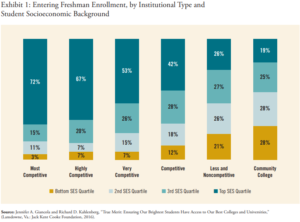
About This Report
Some elite colleges have demonstrated a strong institutional commitment to increasing socioeconomic diversity on their campuses and are working to remove the remaining barriers that block high-achieving, low-income students from enrolling. In this report, we summarize these institutions’ best practices and provide insight into how selective colleges can expand opportunities for outstanding low-income students.
In Their Own Words
“I toured USC one summer and definitely got the
feeling that only wealthy students could attend.
The campus was filled with bricked buildings
and beautiful statues were everywhere. Since it’s a
private school, it will be expensive to attend. Of all
the people that I have known that applied there or
has been there, they all live in well off families.”Cooke Scholarship applicant,
Santa Rosa, California
Our recommendations are drawn largely from the practices of five institutions designated as finalists for the 2016 Cooke Prize for Equity in Educational Excellence, a $1 million prize awarded to a selective college or university that has demonstrated excellence in admitting, supporting, and graduating outstanding low-income students. The 2016 Cooke Prize recipient was Amherst College. The four other 2016 finalists were: Davidson College, Pomona College, Rice University, and Stanford University. We also draw on recommendations from staff at selective institutions that have made increasing access for low-income students a priority, including Allegheny College, Centre College, Brandeis University, Franklin and Marshall College, Grinnell College, Northwestern University, St. Lawrence University, University of California-Berkeley, Vassar College, Wesleyan University, Williams College, and Yale University. All of these schools have demonstrated a strong commitment to increasing the socioeconomic diversity of their student bodies.
Input from institutions is balanced with two additional data sources. We gathered recommendations from representatives of college access organizations (Appendix A, page 51). And we surveyed 2,500 high-achieving high school seniors from low-income backgrounds who applied for the Cooke College Scholarship (Appendix B, page 51, for methodology and sample details).
We recognize that many institutions
are working to increase access and
affordability. And yet, inequality
and underrepresentation still exist –
so we must do more.
Drawing on these data sources, we make 14 recommendations to selective colleges and universities, organized broadly in three areas:
- Encouraging high-achieving, low-income students to apply (page 7)
- Admitting more high-achieving, low-income students (page 25)
- Increasing matriculation rates of high-achieving, low-income students (page 39)
At the end of this report, we include a guide for institutions to review their own practices (pages 48-50).
We recognize that many institutions are working to increase access and affordability. And yet, inequality and underrepresentation still exist – so we must do more. It is in the spirit of continual improvement and progress towards the dream of equal opportunity for all regardless of social pedigree and financial status that we offer these recommendations.
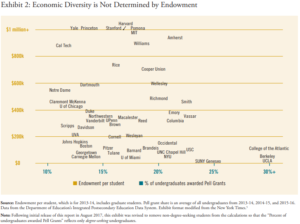
The Application Process
Encouraging High-Achieving, Low-Income Students to Apply
Smart students from low-income backgrounds are less likely to apply to selective schools
even when their abilities and experiences make them ideal candidates for admission. Selective
colleges and universities have an important role to play in encouraging such students to apply.
We offer five recommendations:
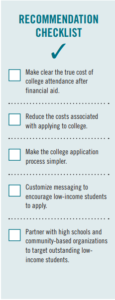
Recommendation 1: Make clear the true cost of college attendance after financial aid.
The stated cost of attending college – tuition, fees, books, room and board, and living expenses – has never been higher. According to the College Board, a “moderate” cost for all these things in the current academic year is about $24,000 for an in-state student at a public institution and almost $48,000 at a private institution – with some schools charging much more.6
Understandably, these high costs give many low-income students and their parents “sticker shock,” as the stated cost of one year of college can exceed a family’s total annual income. This leads many families to conclude that going to any college – let alone an elite private college – is simply unaffordable. As a consequence, many well-qualified students don’t even apply.7
According to administrators at Amherst College, “The largest challenge we face is simply to convince low-income students that they can apply, and that if accepted, they will be able to afford to attend Amherst.”8
In our student survey, we found that about one in three (34 percent) of high-achieving, low-income students reported that the stated costs of tuition, fees, and room and board had discouraged them from even applying to college.9 When asked which institutions they had chosen to not even apply to because of the perceived cost of attendance, students named specific schools (New York University and Duke University were the top responses) and groups of institutions including “the Ivy League” and “out-ofstate institutions.”10
More affluent students and their parents – who are often college graduates themselves – have a much greater understanding of financial aid and how it can lower or completely eliminate the cost of attendance. Low-income parents are not always as savvy. There are, however, ways to address this problem.
In Their Own Words
“It was discouraging looking at all the
schools’ costs. Unless I am awarded
a major scholarship, it will be nearly
impossible for me to attend college.
Many schools to which I applied
offered academic scholarships, which
may have covered tuition, but in
most cases, fees, books, meal plans,
and living expenses more than double
the cost. The merit scholarships that
I was offered did not cover these
expenses. I found that a ‘full tuition’
scholarship doesn’t really mean that
at all.”Cooke Scholarship applicant,
Birmingham, Alabama
Through the Expanding College Opportunities project, researchers at Stanford University and the University of Virginia have demonstrated that simple mailings containing college application advice can have a remarkable impact. Together with semi-customized information about the net cost of attending different types of colleges along with (no-paperwork) application fee waivers, more high-achieving, low-income students than ever before both applied and were granted admission to participating more selective colleges.11
There is much colleges can do to make clear to low-income
students that the real cost of attending is far
lower than the stated price.
Unfortunately, the information typically presented by institutions about costs is often complicated and confusing. There is much that colleges and universities can do to make clearer to low-income students, who are frequently the first in their families to apply to college, that the real cost of attending is likely to be far lower than the sticker price because of the many forms of financial aid.
In Their Own Words
“[Stated costs discouraged me from
applying to] almost all of the schools
I was planning on applying to. Some
schools are need blind, but I wasn’t
confident (after FAFSA) that they
would understand my need. The only
schools I was comfortable applying to
were community colleges.”Cooke Scholarship applicant,
Harriman, Tennessee
Colleges should, at a minimum, do the following:
Discuss financial aid and discounted pricing whenever the cost of attendance is mentioned.
For example, schools should state their tuition as follows: “Tuition is $62,000 per year, except for students who come from families with limited financial means, in which case the tuition may be much lower or waived altogether.” Institutions could also be transparent that tuition is charged “on a sliding scale” based on family income. Currently, there are often several pages of jargon after the tuition is stated. This is confusing and – to low-income students – off-putting.
Provide easy-to-access and clearly stated information about financial aid on all college admissions websites.
This is not a place for legalese. Instead, for example, Wheaton College’s financial aid page clearly states:
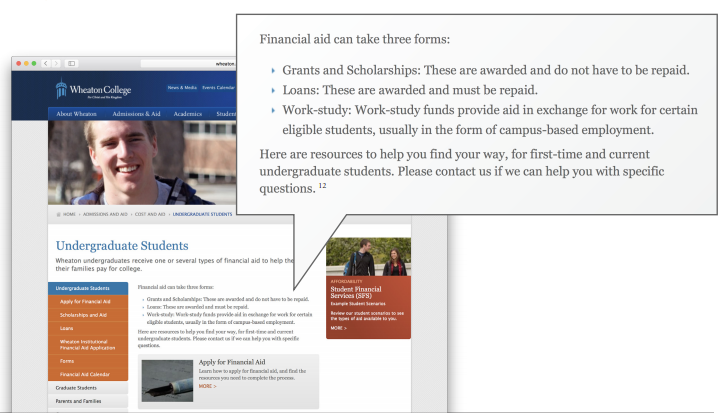
Allow students to estimate attendance costs using net price calculators.
A great resource is Pell Abacus, a free short-cut site designed to allow low-income students to access net price calculators across multiple institutions. Sponsored by ECMC, a non-profit foundation, Pell Abacus is designed to be easy to use by students. It requires only limited knowledge about a family’s financial resources. Inexplicably, 31 selective colleges currently block Pell Abacus, effectively preventing low-income students from receiving an initial estimate of the institution’s “true cost.”13
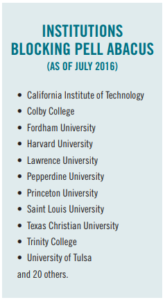
Mention the availability of fee waivers every time the application fee is mentioned.
Communicate clearly any mandatory fees.
Mandatory fees have risen much faster than tuition in recent years.14 Yet fees are not always communicated up-front to students, which can create problems for students working with limited financial resources.
Use accurate and up-to-date information to estimate off-campus living costs.
Researchers have found that one-third (33 percent) of institutions underestimate off-campus living allowances by $3,000 or more, compared to what it actually costs to live modestly in their vicinity.15 This is consumer fraud. Rather than basing living cost estimates on outdated information or relying solely on student surveys, colleges should use up-to-date standardized information and validate student-reported information with reliable data, such as from the U.S. Department of Housing and Urban Development, Agriculture Food Plans, and Bureau of Labor Statistics.
Partner with high schools to educate students about financial aid.
Partner with the College Advising Corps (CAC) or CollegePoint to provide reliable college advice.
The CAC is a national team of approximately 600 college advisors. CollegePoint is a project of Bloomberg Philanthropies and is aimed at helping high-achieving, low-and moderate-income students apply to, enroll in and graduate from top colleges.
Recommendation 2: Reduce the costs associated with applying.
Applying to selective colleges and being competitive enough to gain admission is expensive. We estimate that wealthy students may spend as much as $12,000 or more preparing for and applying to college (Exhibit 3, below). Low-income students cannot afford such investments. Colleges should waive some or all of these costs to make it more feasible for high-achieving, low-income students to apply.
In Their Own Words
“In all honesty, [I was discouraged from applying to] every
school that required an application fee. As a student who
does not qualify for the College Board application fee
waivers, yet faces economic burden, I found myself being
dissuaded from applying to any schools that required a
large application fee ($40+).”Cooke Scholarship applicant,
Rowlett, Texas
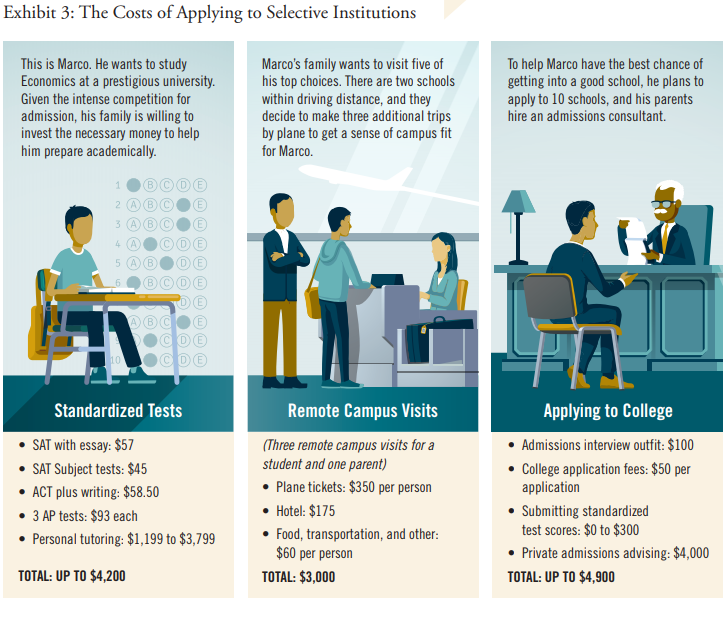
To reduce the costs associated with applying, selective colleges should:
Automatically waive application fees for low-income students – or simply drop application fees altogether.
Certainly, in the case of students from Title I schools (those with large percentages of low-income students), application fees should be waived. If a student is entitled to free-or-reduced-cost lunch in high school, the application fee should be waived.
Pay for prospective low-income students to visit campus.
High-achieving students from families with serious financial need should have the opportunity to visit a campus before committing to attend. Students who are genuinely strong prospects for a particular college should be able to see where they may be spending the next four or more years. Yet only 6 percent of high-achieving, low-income students who applied to a selective institution received financial support to visit the school before completing their application (Exhibit 6).
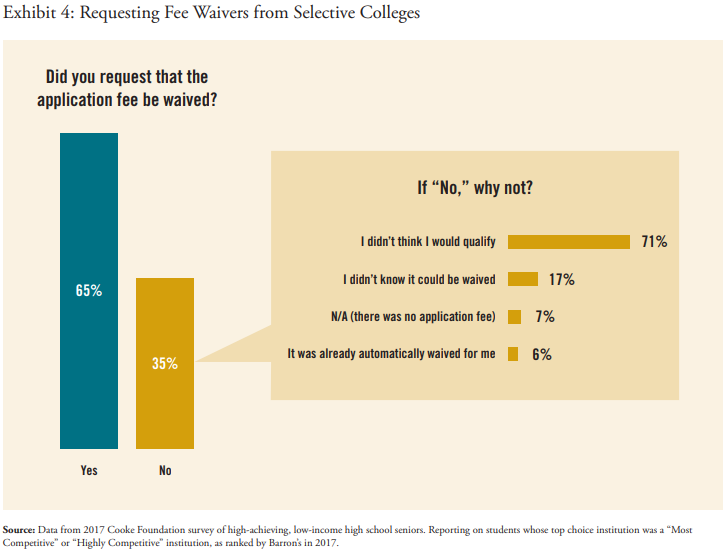
Automatic Fee Waivers
Forty-two selective colleges do not require a fee to apply. We commend these institutions for removing this barrier to high-achieving, low-income students. Most other institutions charge an application fee, ranging from $25 to $90. Some other institutions are moving towards having a free application if completed online, and only charging a fee for students who apply using a paper application. This is somewhat troublesome because in our experience low-income students are more likely to lack online access, and file a paper application. While the majority of schools offer fee waivers to low-income students for their application fee, the process of obtaining these waivers can be arcane. At a minimum, the process for a fee waiver should be straight forward and relatively simple.
Not all low-income applicants eligible for fee waivers request them.16 Only two-thirds (65 percent) of high-achieving, low-income students applying to selective schools request a fee waiver from their top choice institution (Exhibit 4). This is in part because highachieving students from low-income families are not always aware that application fees may be waived; in our sample, fully 17 percent of students not requesting a waiver did not even know that fees could be waived.
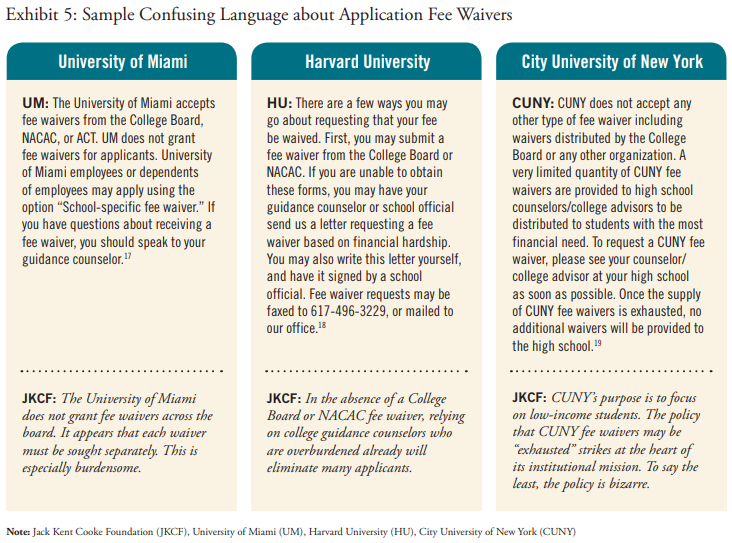
This is entirely understandable, as so often information about fee waivers is tucked away in confusing language on school websites (Exhibit 5) or in arcane policy statements. At some institutions, the onus is on the overworked high school guidance counselor to send a letter requesting a fee waiver. A skeptical reader might think that these processes were intentionally instituted to deter low-income, highly-qualified students from applying. The entire process is questionable and the revenue generated is undoubtedly modest.
Colleges and universities should automatically waive application fees for students who appear to be from low-income families. For example, as a need-blind institution that does not collect family income as part of the application, Amherst College relies on students’ answers to a series of questions regarding the student’s high school, participation in programs (such as the federal free or reduced-price lunch program), and family situation; if any of the answers are “yes,” the student’s application fee is automatically waived. This is a policy calculated to be sensitive to the needs of low-income students.
In 2016, the Coalition for Access, Affordability, and Success introduced automatic fee waivers for low-income applicants in their application. By opting in to the application tool, member colleges and universities make it possible for a student to obtain a single fee waiver that applies to most member institutions.
Campus Visits
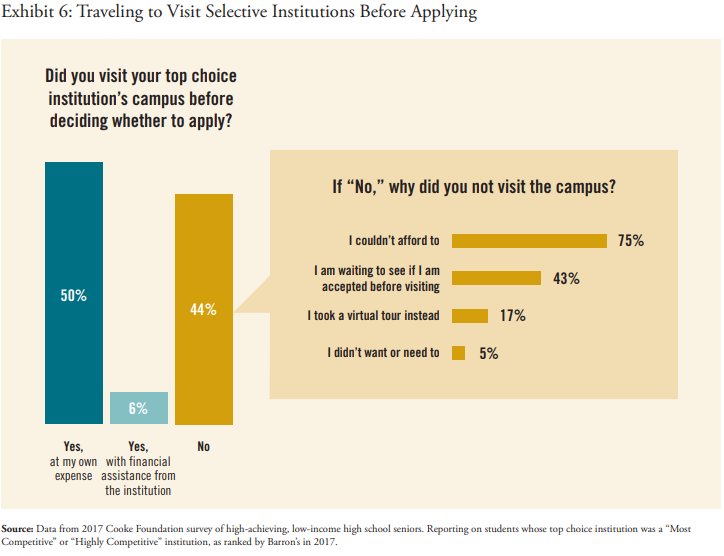
Traveling for campus visits is reported as among the largest barriers faced by low-income applicants, according to both students and representatives of community-based college access organizations (Exhibits 7 and 8, pages 14 and 15). On the one hand, it is simply not reasonable to expect a student to make a four-year commitment to live in a place that he or she has not previously seen. We would not expect this of middle-class or wealthy students. Why would we think that students with financial need – who are already apprehensive about attending college – would be more willing to live in a place for an extended period that they had not previously visited? On the other hand, the cost of a campus visit can be prohibitively expensive, even for a well-endowed institution.
Nearly one in four
high-achieving, low-income
students apply to college
completely on their own
without help from others.
Institutions can help fill
this void.
Yet only about half of high-achieving, low-income students applying to selective colleges (56 percent) visited their first-choice campus before applying, primarily at their own expense. Only 6 percent had travel costs subsidized by the institution (Exhibit 6). The primary reason students did not visit their top choice institution before applying was that they could not afford it.
When possible, institutions should pay for prospective low-income students to visit their campus. Grinnell College, for example, has committed to flying every Pell-eligible student and several domestic students of color to campus for spring events. Institutions should also consider creating virtual tours as an alternative. Only 17 percent of students unable to visit campus report they took a virtual tour (Exhibit 6).
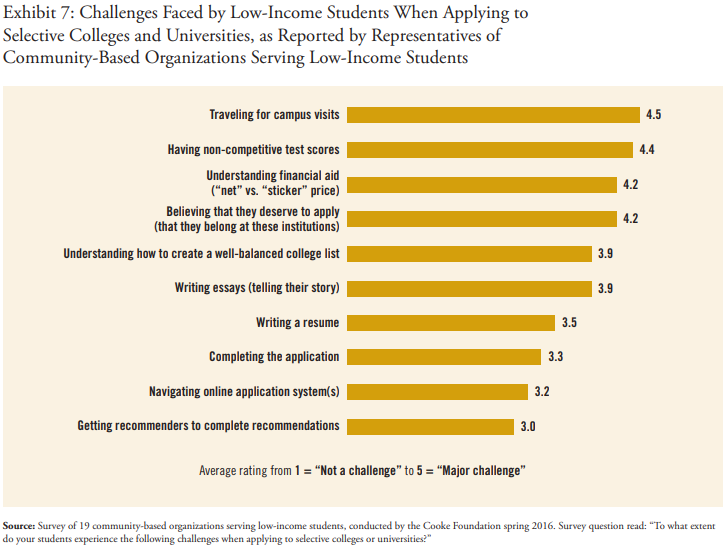
Recommendation 3: Make the college application process simpler.
For middle-class students with educated parents and well-resourced high school guidance counselors, applying to college is multifaceted and complex. For low-income students with parents who in many cases have not attended college themselves – and whose high school counselors are likely over-worked, under-trained, and carrying overwhelming caseloads – applying to college can be like navigating a labyrinth. Indeed, 29 percent of high-achieving, low-income students reported that the admissions process was confusing, most frequently citing questions about how to apply for financial aid.20 Also cited frequently were conflicting deadlines and unclear instructions.
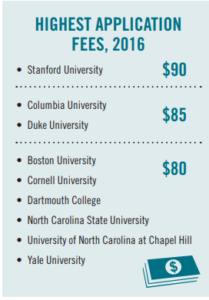
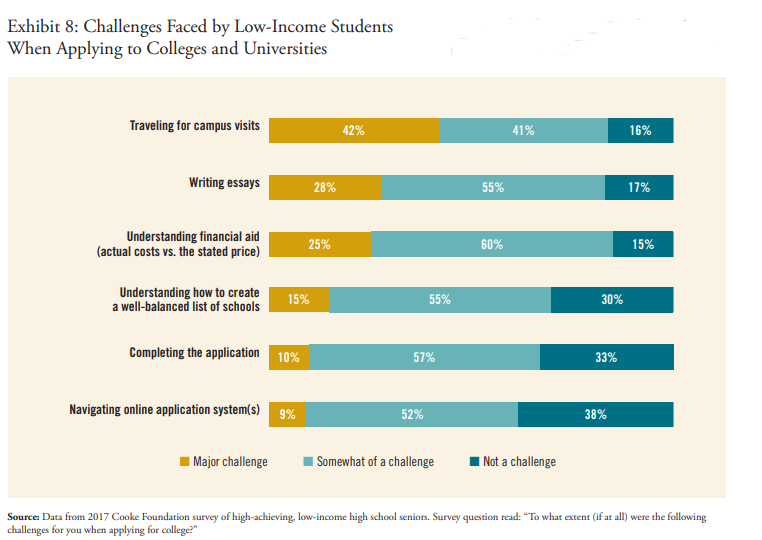
College access programs – such as the Cooke Foundation’s Young Scholars Program – attempt to guide low-income students through this process. At the Cooke Foundation, educational advisers work with students throughout high school to develop appropriate college lists, craft personal narratives, construct essays, and prepare for college entrance exams. The foundation also pays for college visits. Other college access organizations do the same.
In Their Own Words
“The financial aid instructions were
confusing. It was especially confusing
that each of the colleges required
different forms and such.”Cooke Scholarship applicant,
Park River, North Dakota
Yet far more high-achieving, low-income students lack access to an outside advising experience that can help them navigate the admissions process. We have found that 23 percent of high-achieving, low-income students – almost one in four – applied to college completely on their own, without the benefit of teachers, guidance counselors, parents or peer mentors. This places them at a substantial competitive disadvantage with more affluent students (Exhibit 9).21
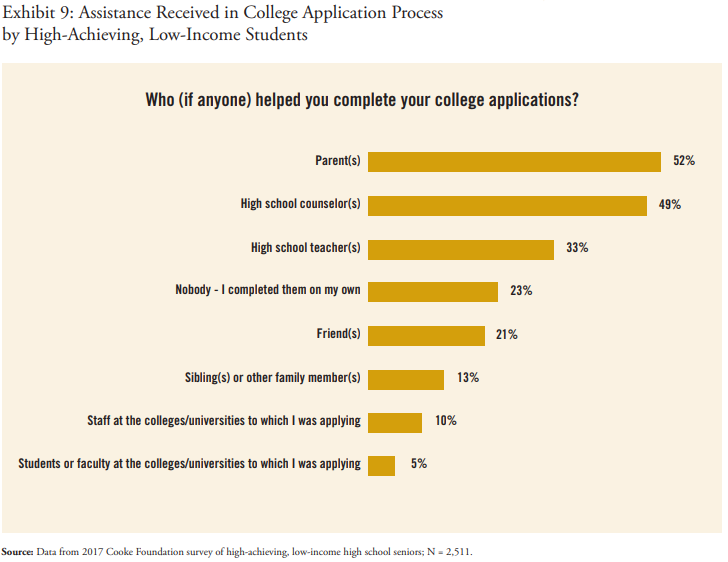
Selective colleges can help these students by making their application process easier and offering extra guidance to students who need it.
Selective colleges should:
Provide more guidance and advice to student applicants upfront, without requiring applicants to ask for help.
At some institutions, admissions staff have begun proactively engaging disadvantaged applicants during the process. We are encouraged that 12 percent of high-achieving, low-income students report receiving help with their application from faculty, staff, or students at the institution to which they were applying.22 Since 2006, Amherst College has matched low-income prospective applicants with current Amherst students from similar backgrounds, who provide the prospective applicants with mentoring and coaching on identifying, selecting and applying to any selective college or university.
Streamline systems and processes across institutions.
For example, all students would benefit from being able to submit their standardized test scores once to central applications (such as the College Board; Common Application; Universal College Application; or the application that has been developed by the Coalition for Access, Affordability, and Success) instead of individually to each school.
Consider ways to guide students through the process, such as using checklists or text message reminders.
Recommendation 4: Customize messaging to encourage low-income students to apply.
High-achieving, low-income students often mistakenly believe that they do not “belong” at selective institutions because they do not know anyone from their home community who has ever attended or even applied.23 In addition, 30 percent of high-achieving, low-income students report that some institutions’ websites, materials, or presentations gave them the impression that only wealthy students attended those schools.24 Careful, sensitive and nuanced messaging is essential to counter these misperceptions.
Pomona College, a 2016 Cooke Prize finalist, has put great effort into intentionally crafting outreach messages that target low-income students, including featuring low-income students on its websites and media communications, and having low-income students speak during orientation. To learn more about Pomona’s efforts, see page 5. Selective colleges should:
Be cognizant that the marketing materials, videos, websites, and other messaging may employ the language and imagery of wealth, which may inadvertently deter applicants with financial need from applying.
Accordingly, each communication should be examined to determine whether it attracts students from all income strata. See, for example, Exhibit 10.
Enlist current students from similar backgrounds to analyze particular communications and to participate in outreach activities with low-income students.
Acknowledge, value, and empower parents and guardians.
For example, include a tab for parents and guardians on the college website, commit to offering transportation to at least some parents and guardians for campus visits, and develop marketing materials and virtual tours in multiple languages.
Exhibit 10: Ensure that Language in Marketing Materials is Inclusive
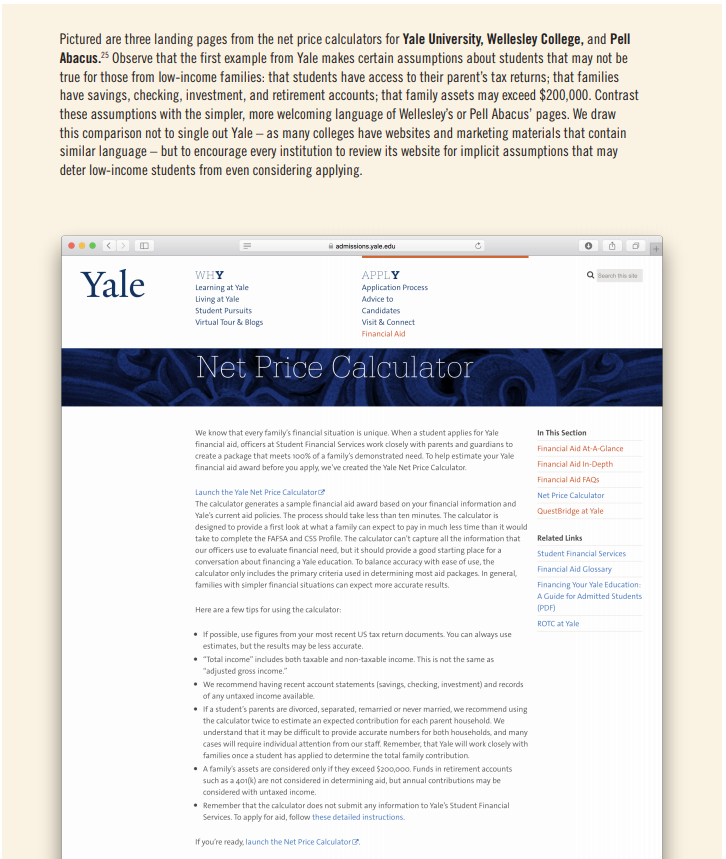
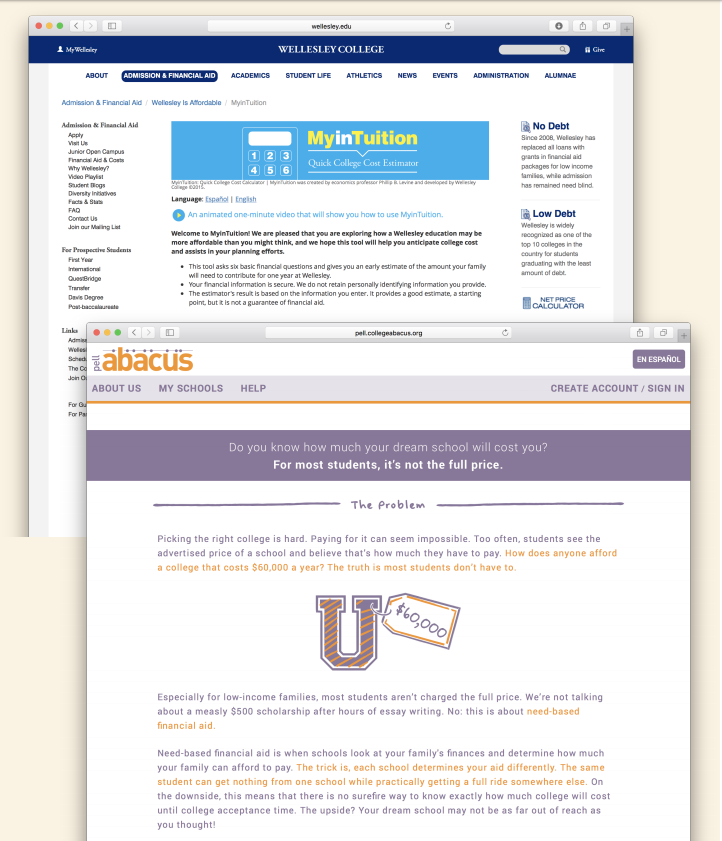
Recommendation 5: Partner with high schools and community-based organizations to target outstanding low-income students.
In Their Own Words
“Fee waivers and financial aid paperwork (the CSS
profile) were super confusing. I didn’t know if I could
email them over or if I had to mail them all. And the CSS
profile asked for a lot of information my parents weren’t
familiar with so we had a hard time figuring out what to
put down.”Cooke Scholarship applicant,
New York City, New York
Appropriate counseling is essential to guide high-achieving, low-income students to colleges and universities that match their talents. Research has shown that students attending high schools with smaller counselor caseloads are more likely to enroll in college.26 Yet many high school counselors in under-resourced districts are strapped with overwhelming caseloads (in excess of 450 students per counselor) and receive little to no training in college selection. Furthermore, many low-income students lack adults in their lives who have gone to college and who therefore can provide at least rudimentary advice in navigating the college admissions process.27
Faculty, admissions staff, and even students and alumni of selective colleges can guide low-income students in selecting colleges. They are often in the best position to identify students who possess both a thirst for knowledge and the academic ability to thrive at selective institutions.
Partnering with high schools and
community based organizations
that serve low-income students is an
essential step selective colleges can
take to expand their pool of highachieving,
low-income applicants.
Partnering with high schools and community-based organizations (CBOs) that serve low-income students is an essential step that selective colleges can take to expand their pool of high-achieving, low-income applicants. To expand their outreach network, selective colleges should:
Have campus representatives visit feeder high schools and CBOs to conduct outreach and educational sessions.
Sponsor campus visits, either as part of the admissions process or as part of summer programs.
Engage faculty members and students to provide guidance to high-achieving, low-income high school students.
Encourage high school counselors and teachers to provide these students with support during the application process.
Encourage college representatives to reach out to middle school and even elementary school students to build a pipeline of high-achieving students with ambition to go to college.
Two-Way Collaboration
“We build relationships [with CBOs]
in order to share information and
best practices. They are telling us the
challenges they have with regards
to their students going to college
and their experiences in college. We
share with them what we’re doing
for our students that resemble the
students they serve. We keep sharing
and exchanging that information. So
we each get better – we get better at
serving their students, and they get
better at preparing their students for
success at Franklin and Marshall.”Donnell Butler,
Senior Associate Dean for
Planning and Student Outcomes,
Franklin and Marshall College
Conduct recruitment visits.
Some of the CBOs surveyed by the Cooke Foundation reported that in their experience admissions representatives from selective institutions primarily visit private schools or suburban public schools, and not high schools attended by low-income students. Admissions staff must engage with many partner organizations to identify disadvantaged students who are eligible for admission to elite colleges. In addition, the admissions staff should have a visible presence on their partner CBO websites. This should include both local collaborations and visits woven into national recruitment trips. The latter are especially important in encouraging smart, low-income students to broaden their horizons. Admissions office staff are not the only college and university representatives who can reach out to low-income students; institutions can also encourage faculty members and administrators to visit partner organizations when they are traveling for other reasons. Many colleges conduct such visits, including Amherst College, Cornell University, Davidson College, Rice University, and Vassar College.
Make extra efforts to establish contacts in your own backyard.
The admissions office at Brandeis University has partnerships with high schools in Boston and in Providence, Rhode Island. Admissions representatives make extra visits to these schools to meet with guidance counselors, host college fairs, conduct essay-writing workshops, and encourage students to visit Brandeis. Local CBOs receive priority for on-campus group visits and benefit from extra offerings like student panels.
Utilize virtual outreach.
In-person visits cannot reach every potential applicant. In recognition of this, Grinnell College has instituted a calling campaign, in which multicultural student interns in the admissions office place phone calls to top prospective low-income applicants.
Don’t stop at one partnership.
No single relationship can serve all of an institution’s recruiting needs. Achieving economic diversity in an institution’s applicant pool requires multiple strategies. Pomona College works with local CBOs in each recruiting region as well as multiple national organizations. There are dozens of national and many regional CBOs that potentially provide contact to high-achieving, low-income students. Appendix C lists some of these CBOs.
Educate high school teachers and staff about selective colleges.
Students are not the only ones who benefit from visiting college campuses; counselors benefit too. Some institutions conduct workshops with counselors so they better understand the characteristics that make successful applicants. When traveling with officials from other institutions, Brandeis University representatives and their traveling partners host a guidance counselor breakfast in each city they visit. Hundreds of counselors are invited to come hear about the schools and their admissions policies. Stanford University every year brings 45 counselors from under-resourced schools to the university during its Counselor Fly-In Program, to learn about Stanford and other selective colleges. St. Lawrence University hosts an annual Counselor Appreciation Dinner, at which it honors the college counselors from neighboring high schools.
Create learning opportunities for Kindergarten through Grade 12 students.
Postsecondary staff and administrators can make presentations on site at CBOs and in schools as ways to establish relationships with those institutions, as admissions staff are limited in the number of visits they can make. Additionally, colleges and universities can strengthen their relationships with K-12 institutions by bringing students to campus.
Rice University has created numerous programs by which local Houston disadvantaged, high-achieving elementary and secondary students come to campus for learning and mentoring opportunities. Rice’s faculty and students are deeply involved with the operation of these outreach programs.
Create scholarships.
Institutions can also establish scholarships for high-achieving, low-income students at specific partner organizations or locations. Such programs can change an institution’s applicant pool, as Centre College found when it introduced the Grissom Scholars program. In the program’s initial year the number of first-generation students applying to Centre College increased from 12 to 20 percent of the applicant pool.
Engage parents as participants.
As one of many of its outreach efforts, Brandeis University is partnering with Emerge, a college access organization that prepares high-achieving students from underserved communities to apply, attend and graduate from top colleges and universities.28 “These students are very well-prepared,” says one admissions officer. The biggest obstacle Brandeis encounters when recruiting Emerge students is their tendency to attend local colleges. “Especially for students who are first-generation, who didn’t grow up considering going to a four-year college or leaving the state, changing mindsets by really including families in those conversations” is important. During recruitment events, Brandeis admissions staff also make concerted efforts to engage parents in conversations about the merits of a liberal arts education and of the option of attending college out of state.

Engaging Students
The Students Exploring and Embracing Diversity (SEED) program at Brandeis University brings high school seniors to campus to stay with a Brandeis student, attend a course, and participate in an interview with admissions staff. Students must be high-achieving and complete an application, which is competitively reviewed.
St. Lawrence University created a merit scholarship limited to students from neighboring high-poverty schools. Each high school can nominate up to two students annually for the award. All nominated students are brought to campus for a celebratory dinner, allowing students to visit campus and be recognized for their good work.
Centre College has the Grissom Scholars program, a cohort-model scholarship that targets first-generation students. There is no GPA or test score cut-off for the scholarship; rather, staff review applications holistically, looking for high character, high academic achievement, and leadership potential. Awardees must have very high financial need and be first-generation college students. Ten scholars are chosen per year, and all finalists are brought in with a parent for a weekend to visit campus. In addition to a full-tuition scholarship, scholars receive a laptop and a peer mentor. They arrive at campus a week early for an orientation retreat.
The Admissions Process
Creating Equal Opportunities; Admitting More High-Achieving, Low-Income Students
Even when low-income students do apply to selective colleges, as documented in our earlier
“True Merit” report, their chances of being admitted – notwithstanding that they have the
same or superior grades – are lower than high-income students. What can institutions of
higher education do to increase the likelihood of admitting more low-income students?
We offer five recommendations.
Recommendation 6: In evaluating applications, recognize the barriers low-income students have already overcome.
Low-income students have much less access to advanced learning opportunities than their higher-income peers.29 Their high schools often lack college-level coursework (such as Advanced Placement and International Baccalaureate courses) and their school counselors have unmanageable caseloads. They frequently attend high schools that are focused primarily on bringing students up to proficiency (rather than on challenging advanced students). Finally, parents of low-income students are often unable to provide academic support at home, and lack the funds to purchase any supplemental learning experiences – such as prep courses for the SAT and ACT, summer camps, tutoring, college courses, and participation in regional and national science competitions.
When it comes time to complete college applications, low-income students receive less guidance, fewer consultations, and less assistance in essay writing. Their counselors are overworked and sometimes undertrained in counseling high-achieving students.30
Their parents – as previously noted – are usually not college graduates themselves and are therefore unable to help them write essays or navigate online applications. As a result, college applications from low-income students often can appear to be lacking in polish when compared to those of wealthier students.
Recognizing the distance high-achieving, low-income
students have traveled to arrive at the gates of selective
college admissions is the single most important step
institutions can take.
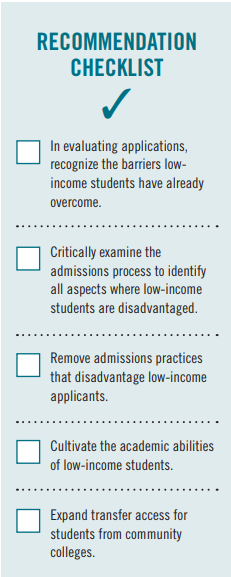
Selective colleges should:
Be mindful of – not blind to – a student’s financial background.
Look carefully for signs of academic aptitude.
Compare students to others from similar backgrounds.
Give low-income students who have reached high levels of academic achievement credit for overcoming the barriers of growing up in circumstances of financial need.
Train readers to review low-income applicants with sensitivity to their circumstances.
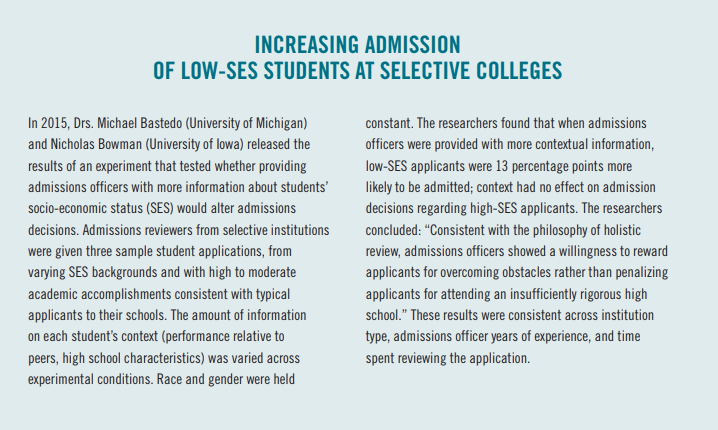
Take note of a student’s background.
Reviewing applications on a “need-blind” basis does not mean being blind to students’ diminished life experiences and reduced opportunities. Colleges must be sensitive to clues as to whether a student grew up with limited means. These include whether a student is a member of a racial or ethnic minority, the parents’ level of education, the parents’ occupations, whether they live in an identifiable racial or ethnic neighborhood, what language is spoken at home, the number of siblings, the quality and location of the student’s high school, the high school’s catchment area, whether the high school is a Title I school, and the student’s ZIP code.
Both Yale University and Rice University, for example, examine multiple factors to identify students from “under-privileged backgrounds,” including first-generation status, race/ethnicity, high school quality, and residential ZIP codes.
Such practices have been incorporated by institutions wanting to better understand students in context. New research demonstrates that reviewing students’ academic performance in the context of their socioeconomic background not only is crucial to address the reader’s latent biases, but also results in higher acceptance rates of low-income students.31 This research underscores that reviewing applications “need-blind” should not mean that a student’s access to opportunities while growing up is not taken into consideration.
Look carefully for signs of academic aptitude.
A low-income student who travels a long distance to get a better high school education demonstrates ambition and dedication, even though the extended commute may preclude the student from extracurricular activities. Low-income students may also report fewer extracurricular activities because they lack funds to pay fees, may need to spend time after school working, or may need to care for a sibling or other relative. Colleges also need to recognize that students’ commitment, drive, “grit” and other factors are themselves good predictors of collegiate success.32
One admissions officer at Allegheny College said on assessing determination and character, “it’s not always quantifiable but when conducting a holistic review, an admission representative can usually discern if a student will work hard and/or contribute positively to the campus community.”
Compare applicants with students who attended similar types of high schools.
Rather than comparing students from a school serving primarily low-income students to students from wealthier schools, colleges need to recognize that letters of recommendation from overworked public school teachers may not read as well as glowing accolades from private school teachers.
According to Rice University administrators, “the greatest challenge in evaluating applicants is that students apply to Rice from high schools whose quality and resources vary significantly. To overcome this challenge and ensure that students are not disadvantaged in the selection process for having attended under-resourced schools, our admissions office implemented a system in 1992 to classify applicants’ high schools according to the resources, curriculum, and college preparation programs offered. Students are compared with other students from similar high schools and not against students who attended more affluent schools.”33
Give low-income students credit for overcoming the barriers of financial need.
Low-income students who have reached high levels of academic achievement deserve credit for overcoming the barriers of growing up in circumstances of financial need without appreciable external assistance. A student from a low-income background who gets high grades and test scores despite growing up poor has accomplished more than a wealthy student with similar accomplishments but far more assistance. When appropriately designed, the admissions process can create equal opportunities for low-income students to shine by recognizing the distance such students have traveled to overcome significant barriers. Without thoughtful review, admissions processes may give inadvertent advantage to wealthy students. For example, recent research suggests that wealthy students who “max out” a rigorous curriculum by taking the most high-level courses available receive a boost in admissions, but lowincome students who do the same do not similarly benefit with the increased likelihood of admissions.34
Train readers to review low-income applicants with sensitivity to their circumstances.
Whatever the definition of holistic review utilized, it is important to have appropriate reader training, both to align readers with the institution’s chosen definition and also to increase their awareness of their own implicit biases.
Pomona College trains its admissions readers to be aware of student backgrounds, including the role played in student outcomes of a variety of factors such as languages spoken at home, parent education, parent occupation, student jobs, number of siblings, and the distance the student has traveled from home to attend high school.
Recommendation 7: Critically examine the admissions process to identify all aspects where low-income students are disadvantaged.
A review of the extent to which low-income students apply, are accepted and matriculate can identify stages of the admissions process where low-income students are disadvantaged or are discouraged from applying. For example, one study of 19 selective colleges found that low-income students made up 12 percent of the applicant pool, but only 9 percent of admitted students.35
In our conversations with admissions staff members of multiple institutions, we were told that because the institution was “needblind,” admissions staff did not collect students’ incomes, and thus could not examine admissions outcomes by income. That is not just “need blind” but willfully blind to some of the most critical aspects of a student’s background, personal history and family story.
Institutions should collect income information to assess the equity of the admissions process. The information can easily be removed from files during the selection process if a “need-blind” review is desired. As previously noted, other socioeconomic traits should also be examined, as indicators that a student may be lowincome, such as parental education level, ZIP code demographics, and poverty rate of the attended high school.
In the same way that attention may be given to ensuring diversity of geographic origin, gender, or race and ethnicity, attention should be paid to socioeconomic diversity. Selective colleges should:
Collect income information from applicants and use it to identify stages of the recruitment and admission processes where low-income students are disadvantaged.
Recommendation 8: Remove admissions practices that disadvantage low-income applicants.
Many common admissions practices at top colleges (presumably unintentionally) disadvantage outstanding low-income students. For example, colleges that grant a preference to applicants who have visited their campus, as a sign of demonstrated interest, disadvantage low-income students who cannot afford to travel. Similarly, selective institutions should re-examine their admissions processes to assess how low-income applicants fare and whether any admissions practices give unfair advantages to more affluent applicants.
Our previous report, True Merit, outlines in detail the admissions practices that disadvantage low-income students. Specifically, we recommend that selective colleges:
Critically assess the use of standardized test scores (i.e., SAT, ACT).
Eliminate preferences given to legacies.
So many other factors contribute to academic success that it is unfair to pretend that analytic gifts are genetically determined.
Eliminate athletic preferences.
Athletic preferences should be eliminated if they are systematically disadvantaging lower-income applicants by giving credit for sports not often played at schools serving low income students, such as water polo and crew.
Eliminate early admissions programs.
Or (at a minimum) critically examine how low-income students fare in the early admissions process so as to analyze properly the impact on overall admissions.
In the same way that attention may
be given to ensuring diversity of
geographic origin, gender, or race
and ethnicity, attention should be
paid to socioeconomic diversity.
Recommendation 9: Cultivate the academic abilities of low-income students.
While some high-achieving students from low-income backgrounds arrive at college well-prepared for the rigors of a selective postsecondary curriculum, others have had fewer opportunities for advanced college-level coursework. High-achieving, low-income students are less likely to take Advanced Placement courses, International Baccalaureate courses, or dual enrollment courses.44 They also often lack summer enrichment experiences that wealthier students enjoy.
Selective colleges can help level the academic playing field for talented low-income students and increase their chances of gaining admission by:
Creating opportunities for students to attend academic summer programs on campus.
Educating K-12 students throughout the school year.
Instructing K-12 teachers on best practices for teaching high-achieving, low-income students.
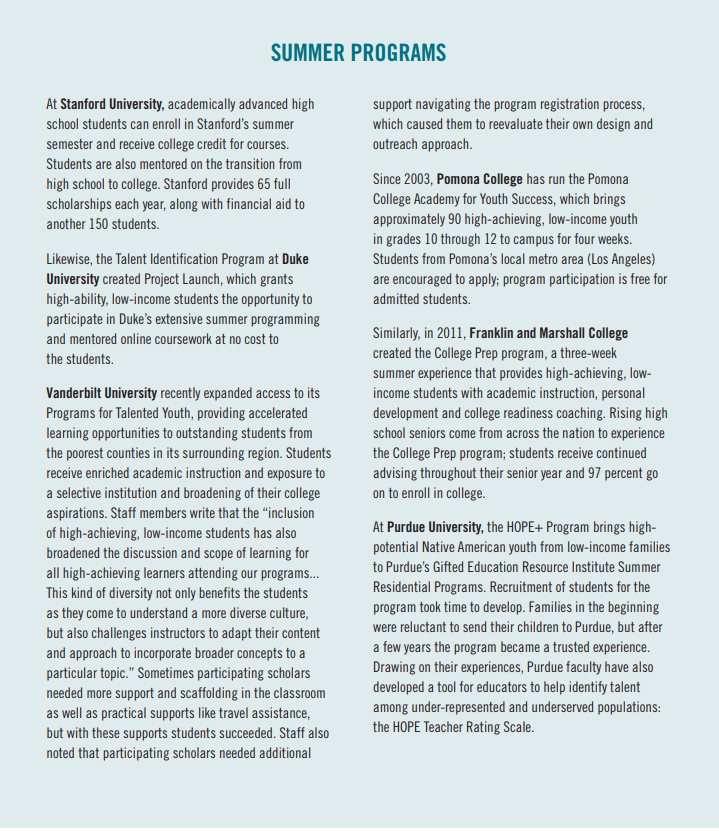
Create On Campus Summer Programs.
Many colleges run academic enrichment programs for K-12 students during the summer on their campuses. Such programs offer students the chance to experience many aspects of college life, from instruction by professors to dormitory living. Colleges should create opportunities for high-achieving, low-income students to attend summer programs, either by devoting scholarship funds to existing programs or creating new programs specifically targeting such students.
Since 2005, Davidson College has been a partner site for Freedom Schools, which provides summer enrichment focused on teaching children to read and gain positive attitudes towards learning. Davidson undergraduate students intern as assistants in the program, which has been shown to increase students’ reading levels and self-esteem relative to learning. Other examples of such programs are noted later.
These institutions’ experiences suggest the following recommendations for expanding summer programming:
- Students benefit when college advising is incorporated into the programming.
- Faculty may need to adapt instructional methods to accommodate for the academic readiness of students from under-resourced schools.
- Recruiting low-income students may demand changes in outreach methods. Students may need assistance navigating program applications.
Initiate School Year Learning Opportunities.
Educational opportunities for high-achieving, low-income students should not be limited to the summer. Some institutions have initiated efforts to educate students during the school year. These efforts take many forms, from sending undergraduates to mentor elementary school students to bringing high school students into campus laboratories to conduct research. Other institutions have created dual enrollment programs that are free for low-income students.
- Bard College has, for two decades, operated early colleges in urban settings where many students are low-income.45 Students attend free of charge, benefit from small class sizes and instruction by college faculty, and 90 percent earn an associate degree before graduating.
- Northwestern University operates an academy for socioeconomically disadvantaged Chicago public school students who qualify for selective admissions high schools but are not accepted. Students receive instruction throughout the year and during the summer, tutoring, leadership development, academic and college counseling, and workshops geared towards educating families.
Create Professional Development for Teachers.
Educating individual students is important, but can only reach one student at a time. A more lasting impact may be the creation of professional development opportunities for teachers, especially focused on knowledge and skills teachers may need to best educate high-achieving, low-income students.
- The Rice University School Mathematics Project connects the Rice Mathematics research community with Houston area mathematics teachers, providing professional development, academic-year support, and program evaluation for schools and districts. Since 1987, the project has supported nearly 9,000 teachers and school leaders from 66 districts and charter schools.46
- Vanderbilt University hosted a conference for local K-12 school personnel and community leaders on the intersection of poverty and gifted education, with the goal of educating stakeholders to better identify and support high-achieving, low-income students.
Recommendation 10: Expand transfer access for students from community colleges.
The number of transfer students admitted by selective colleges is small. In 2014, selective private colleges admitted an average of 111 students per institution from either community colleges or four-year institutions, while at public universities the average was 1,407. Collectively, selective institutions accepted over 64,000 transfer students, representing 5 percent of their student bodies.47 Most of these students transfer from other four-year institutions; only one of every 1,000 students enrolled at the nation’s most selective private colleges and universities transferred from a community college.48 This is unfortunate as there are many talented students in community colleges who could perform at a high level at even the most selective four-year institutions.
Four-year institutions that do not recruit high-performing community college transfer students are missing an important pool of potential applicants. Many community college students had distinguished high school academic careers; 11.5 percent graduated with a high school GPA above 3.5.49
The Cooke Foundation’s Undergraduate Transfer Scholars are a shining example of this: of the 332 Cooke Transfer Scholars who transferred from community college to attend selective colleges and institutions and have since graduated with foundation support, 97 percent have graduated with an average grade-point average of 3.6.50 Our scholars are only the tip of the iceberg. Every year, thousands of talented, highly motivated students graduate from community colleges with the potential to succeed at selective institutions.
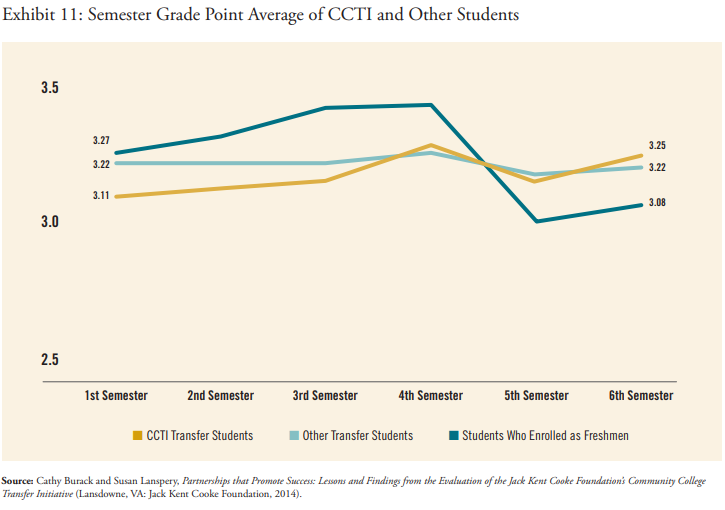
Besides the Cooke Foundation, there are several other organizations in the nation devoted to helping high-achieving community college students transfer to four-year institutions (Appendix D, page 54). Selective colleges that fail to avail themselves of these highly talented applicants are denying themselves a ready source of outstanding low-income students.
Selective institutions should consider transfer applications not just from other four-year institutions, but from community colleges as well. Yet our research shows that only 63 percent of selective colleges accept transfer credits from two-year institutions, and only 56 percent have articulation agreements with community colleges.
To address this issue, between 2006 and 2014 the Cooke Foundation provided funding to 14 selective colleges to expand their connections with community colleges under its Community College Transfer Initiative (CCTI), including: Amherst College, Bryn Mawr College, Bucknell University, Cornell University, Loyola Marymount University, Mount Holyoke College, Southwestern University, Syracuse University, University of California-Berkeley, University of California-Los Angeles, University of California-Santa Barbara, University of Michigan Ann Arbor, University of North Carolina-Chapel Hill, and University of Southern California.
Potential transfer students were identified through various means, including participation in honor societies, enrollment in honors classes, and achieving a high GPA. On the whole, CCTI students were highly successful academically at their four-year institutions. Very few dropped out or failed classes, and CCTI students consistently earned about 95 percent of the credits they attempted. On average, the transfer students maintained grade-point averages above 3.0 (on a 4.0 scale), and their grades were on par with those of other transfer students and students who enrolled as freshmen (Exhibit 11).
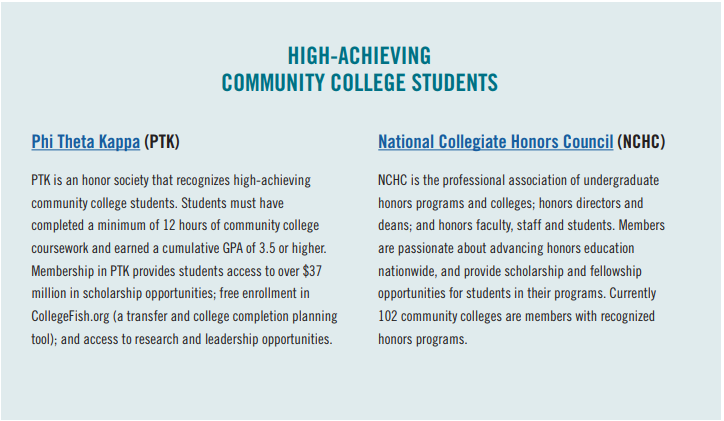
An evaluation of the grant initiative suggests that for maximum success, institutions must work with community colleges to identify and prepare the right students for transfer, then support students both through and after transfer.51 Recommendations from the CCTI program for selective colleges include:
Establish Institutional Buy-in:
Commit to expanding transfer access for community college students.
Create a collaborative cross-campus plan, and designate key point personnel from both faculty and administration to facilitate the joint enterprise.
Provide Pre-Transfer Support:
Identify prospective students early.
So that there is more time for students to visit the four-year school’s campus and be well-prepared academically.
Increase student readiness for success by:
- appointing a campus “point person” for community college transfer students;
- organizing peer and staff mentoring;
- providing joint classes and summer academic programs;
- working with community college faculty to align curricula; and
- providing workshops and other opportunities for students to learn about succeeding at the four-year institution.
Provide Post-Transfer Support:
Improve credit transfer policies.
Make transfer policies as clear, transparent, and individualized as possible. This includes developing articulation agreements where feasible.
Develop social integration strategies.
These strategies (cohort activities and faculty, staff, or peer mentoring) should help community college transfer students feel like they belong.
Designate one or more “trusted agents.”
“Trusted agents” should help students navigate the transition, answer questions about everything from parking to advising, and trouble shoot.
In our study, the most effective programs had robust partnerships between community colleges and four-year institutions. These partnerships identified key individuals on both campuses focused on facilitating student transfer; established structures to facilitate frequent communication; and were mutually respectful, stressing the importance of learning from each other. The most successful institutions also involved students in the partnership to help with outreach, support other students after transferring, increase the program’s visibility, and provide important feedback and recommendations.
For example, the Exploring Transfer Program is a summer program at Vassar College that brings first-generation community college students from around the country to live in a Vassar residence hall and experience life at an elite, small liberal arts college. All accepted students receive a scholarship that covers their tuition, room and board, books, and supplies.
In recent years, Amherst College has increased its acceptance and support of community college transfer students. In recognition of their commitment to expanding access for low-income students, including transfer students, Amherst was awarded the $1 million Cooke Prize for Equity in Educational Excellence in 2016 (see page 37), and Vassar was awarded the prize in 2015.
Encouraging Enrollment
Increasing Matriculation Rates of High-Achieving, Low-Income Students
Just offering admission is not always sufficient to result in a student’s enrollment. Our next
four recommendations offer strategies for ways selective colleges can help encourage admitted
low-income students to enroll.
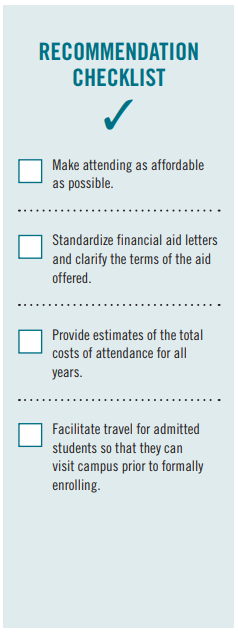
Low-income students need to be able to afford to pay for college – not just tuition, but room and board, transportation, living expenses, and all of the supplemental costs that come along the way. Financial aid packages are the top reason low-income high school valedictorians cite for choosing which institution to attend (Exhibit 12).
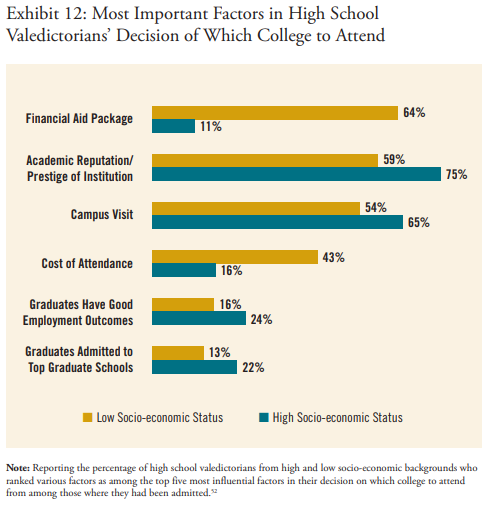
And yet the average net price for attending a selective college varies widely for low-income students. In 2014, students from families making less than $30,000 attending a selective college or university paid an average net price ranging from under $1,000 to over $30,000.53 Only 40 percent of institutions have an average net price for these lowest income students of under $10,000 per year (Exhibit 13, below), meaning the majority of low-income students are being asked to spend between one-third to almost all of their families’ annual income on their college education. This is totally unrealistic. Institutions that ostensibly offer aid but then require a student’s family to commit essentially its entire annual income to cover tuition and other costs of attendance are guilty of false advertising. Worse, they are raising hopes with one breath to dash them with another.

Some selective institutions commit to meeting full financial need without loans. Other institutions require low-income students to work or take out loans to cover the costs. Recent research suggests that removing all loans from low-income students’ financial aid packages increases low-income enrollments at selective institutions.54
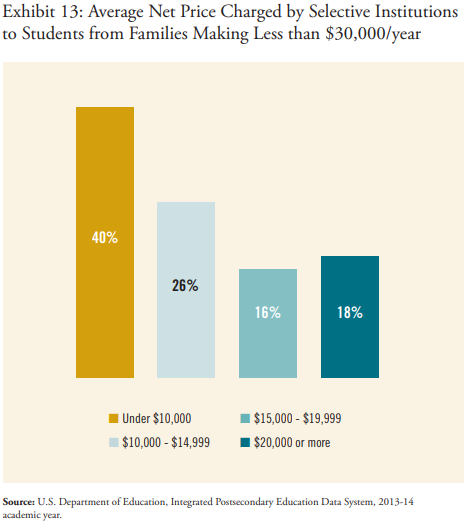
Meeting full financial need without excessive loans or work expectations requires that institutions creatively increase their financial aid budgets.
- Grinnell College holds separate fundraising campaigns to raise money for financial aid.
- Vassar College’s former president enlisted the support of the Faculty Senate in prioritizing financial aid over other expenses, including postponing campus construction projects.
There are other practices that can impact students’ likelihood of being able to afford to attend. Selective colleges should:
- Consider both big and small costs. At Williams College, students receiving financial aid do not pay anything for their required books and course materials.
- Recognize students’ obligations to help support their families. In recognition that students might need to contribute to household expenses, their own expenses, or might have other family obligations that prevent summer saving, Amherst College reduces the expected “summer savings” contribution for low-income students. For the institution, these summer work contributions are relatively minor, while for students’ families they can determine whether they have to ask for public assistance.
- Educate students about other social benefit programs for which they might qualify. For example, the Supplemental Nutrition Assistance Program (SNAP, i.e., food stamps); the Special Supplemental Nutrition Program for Women, Infants, and Children (WIC), and non-educational tax credits like the Earned Income Tax Credit (EITC) all may offer support to low-income students. However, few college students use them or are aware of them.
On the flip side, there are practices that affirmatively hurt the chances of low-income, high-achieving students from succeeding at selective colleges. Selective colleges should not:
- Intentionally give low-income students a low financial aid offer, so that these students will choose to go elsewhere.
- Discriminate against independent students, who have been shown to be not dependent on their families for support. Institutions should meet 100 percent of demonstrated need of independent students.
The amount of merit aid awarded to
students from higher-income families
has doubled since the mid-1990s and
now exceeds the amount of funding
provided in need-based aid.
Finally, merit aid should be used with caution. The amount of merit aid awarded to students from higher-income families has doubled since the mid-1990s and now exceeds the amount of funding provided in need-based aid.55 Many institutions award merit aid to less meritorious, yet full-paying students. Offering merit scholarships helps attract middle-class and wealthy students who can pay most of their college costs, yet reduces the amount of money available to make college affordable for low-income students. Institutions should consider carefully how “merit aid” is allocated.
- Merit aid should not be awarded based solely on high standardized test scores, which are proven to correlate with income.
- Institutions should create merit scholarships for high-achieving, low-income students. For example, Hendrix College created the Hendrix Arkansas Advantage program in 2014 to provide full-need scholarships to Arkansas high school graduates who meet certain academic requirements.
- As much as possible, financial aid should be awarded based on need. Institutions with the financial capacity to meet full need should not use financial aid to “woo” students. For example, 23 selective institutions (13 percent) are part of the 568 Presidents’ Group, a collaborative of institutions that have agreed to award financial aid based solely on demonstrated financial need.
Recommendation 12: Standardize financial aid letters and clarify the terms of the aid offered.
Financial aid award letters accompany many offers of admission. The content and format of these letters is so varied that two years ago Forbes published a piece headlined, “10 Rules for Decoding College Financial Aid Award Letters.”56
A review of award letters provided to Cooke Scholars suggests much variation across the letters used by selective colleges. Common confusing elements include the following:
- Failure to clearly separate grants (money that does not need to be repaid) from loans (money that must be repaid).
- Lack of clarity on some estimated costs (what are “personal and miscellaneous” costs, for example?).
- Omission of fees from the estimated costs.
- Statement of out-of-pocket costs as “$0” when packages include thousands of dollars of loans.
The federal government recently created a uniform financial aid award letter template called the Federal Shopping Sheet (Exhibit 14). Twenty-six percent of selective colleges use this form, and another 38 percent use it with veterans only. Fully 60 selective institutions have completely adopted this form. Other institutions should provide the critical information in this or a similar standardized format, which would make it vastly easier for students to compare packages across institutions.57
Whether using the federal form or an institution’s own, award letters should make clear:
- The amount of grant aid the student is receiving, with clear language indicating that grants are gifts that do not need to be paid back;
- The source of each grant;
- A separate section outlining possible sources of funding to pay the net cost (the difference between cost of attendance and grant aid);
- Clarification that loans must be repaid and that loan amounts are suggested, not required.
- A clear statement of how much money the student and family will need to pay, including acknowledgement that loans must be repaid.
Furthermore, letters should also address future years’ support, by referencing eligibility and renewal.
- At the time of award offering, institutions should make clear the eligibility requirements for maintaining each source of grant funding, such as grade-point average requirements or minimum credit load requirements.
- Aid letters should make clear that grants (including federal aid) must be renewed annually and provide instructions on how students can renew their aid.
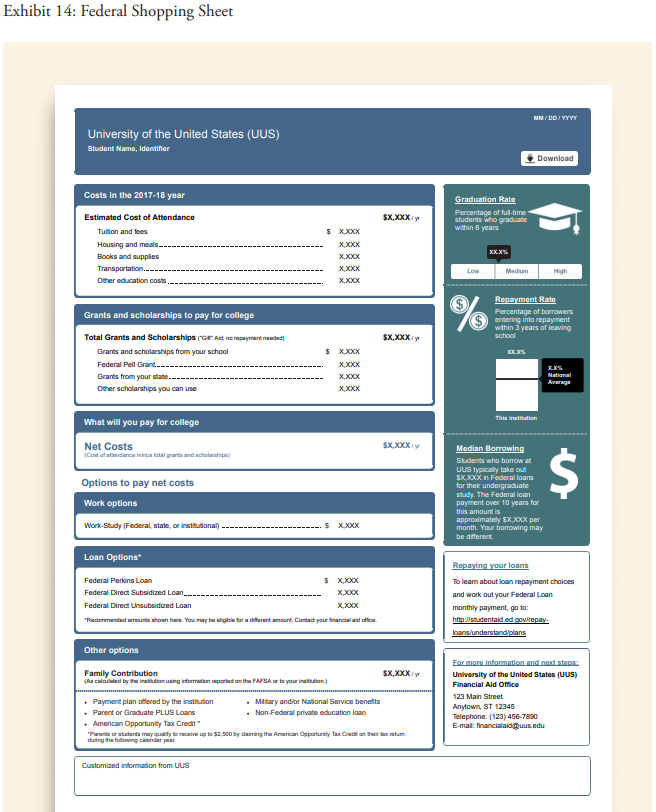
Recommendation 13: provide estimates of the total costs of attendance for all years.
All institutions must now have a “net price calculator” on their websites. In addition to providing a cost calculator that is more friendly to the low-income applicant (see Recommendation 1), institutions should also find ways to estimate the approximate full cost of their degree for all years of study.
Many low-income students assume that the price they pay in their freshman year will be the same price for all four (or more) years of college, or that the aid they receive in their first year will continue in subsequent years. Yet research shows that institutional grant aid for students at private colleges drops, on average, $1,000 between their freshman and senior year.58,59
Selective colleges should:
- Be explicit that prices may (or will likely) change.
Also include estimates of the percentage change anticipated.
- Clearly identify whether aid is renewable.
If not renewable, make clear it is a one-time freshman year grant.
Even better would be commitments of financial aid for multiple years. Brandeis University provides 20 students admitted each year into its Myra Kraft Transitional Year Program (a support program for under-resourced students) with a guaranteed 100 percent of demonstrated financial need for five years.
Recommendation 14: Facilitate travel for admitted students so that they can visit campus prior to formally enrolling.
Traveling for campus visits is the most challenging obstacle that students face when seeking admission to selective colleges (Exhibits 6 and 7). Yet campus visits can play a major role in influencing a student’s decision to attend.
Selective colleges should:
- Pay for admitted low-income students to visit campus.
Stanford University offers travel grants to admitted low-income students to attend Admit Weekend, a three-day program that educates students about Stanford’s educational opportunities, residential life and campus resources.
Conclusion
Colleges and universities have traditionally been engines of social mobility. However, at our nation’s most selective colleges, there are 24 times as many high-income students as low-income students. We are currently at risk of selective institutions becoming engines of social stratification.
When high-achieving students from low-income families are admitted to selective institutions, the vast majority thrive, earning high grades and graduating at rates at least equal to their wealthier peers. The key to getting more of these amazing low-income students into selective colleges is recruiting them, guiding them through the application process, reviewing their applications (taking into account the distance they have already traveled to get there), and then supporting them both financially and emotionally.
We are keeping far too many bright but poor young people out of our most prestigious colleges. Doing so betrays our fundamental values that those who are ambitious, work hard and play by the rules can achieve upward social mobility and financial success.
Selective colleges and universities must commit to expanding access for high-achieving, low-income students and opening the doors of our higher education system to students based on true merit rather than family income. To do so requires a comprehensive, campus-wide review of resource allocation, selection practices, and financial and emotional supports offered. It also requires removing inadvertent barriers and providing support so that the goal of equal opportunity for all, regardless of social pedigree, can be realized.
To guide these efforts, we provide a check list that institutions can use to review their own practices and identify additional actions they can take to expand access for students from low-income families. It is imperative that each institution review its own beliefs and practices to identify changes – big and small – that will encourage more economically diverse students to enroll. By opening college doors wider, we ensure that college selection is based not on parental wealth or income but on students’ academic abilities and achievements.
University Checklists
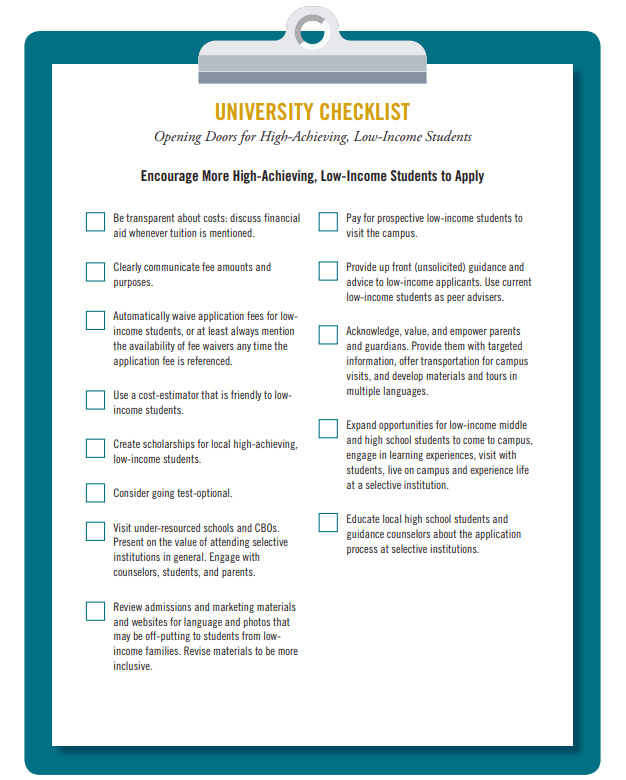
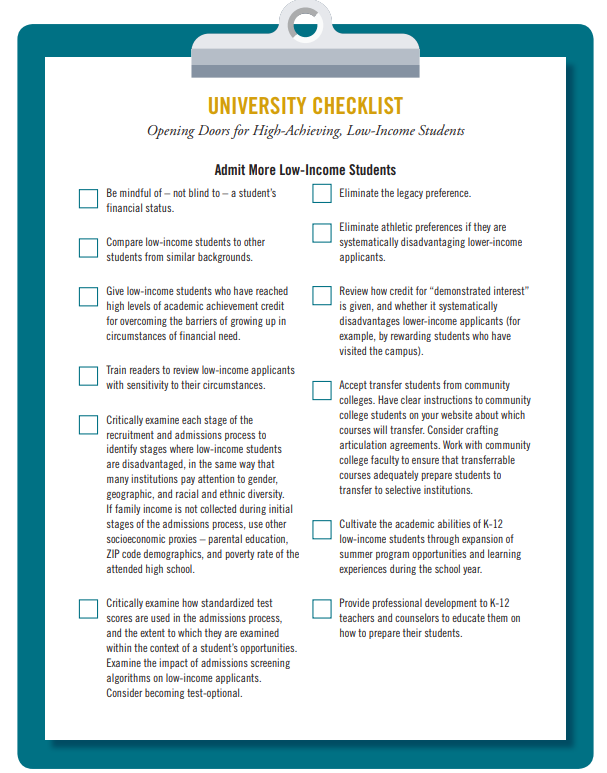
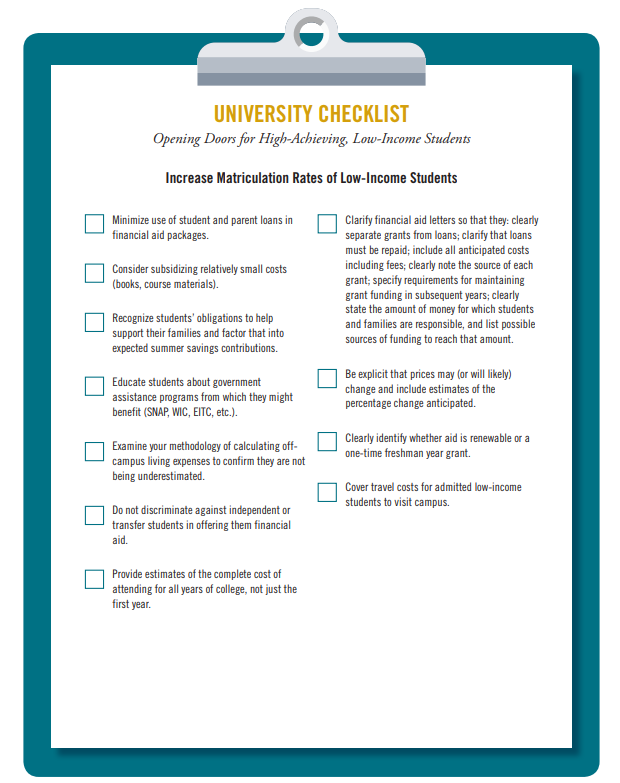
Case Studies
Pomona College | 2016 Cooke Prize Finalist
A liberal arts college with an enrollment of 1,650 students, Pomona College is committed to recruiting low-income, community college, first-generation, immigrant, refugee, and undocumented students from ethnically diverse backgrounds. As outlined in the institution’s strategic plan, “Lighting the Path to 2025: A Vision for Diversity,” Pomona believes that diverse perspectives create the most transformative learning experiences, and has dedicated significant human and financial resources to diversifying its student body.
Pomona College meets the full demonstrated financial need of students (including undocumented students who graduate from U.S. high schools) with grants, scholarships, and a small work stipend, without loans. As part of the White House College Pipeline Initiative of 2014, Pomona’s president committed the institution to increase enrollment of Pell-eligible students to 20 percent. Pomona has since exceeded that goal, enrolling 22 percent Pell-eligible students in 2015-16.
Pomona has developed recruitment and admissions strategies to address the specific needs of underrepresented students. Admissions readers are trained to be aware of students’ home and school conditions. Five admissions officers comprise the Admission Office’s Diversity Team, which keeps abreast of research and makes recommendations.
In admissions outreach, Pomona pays particular attention to low-income, first generation, transfer, immigrant, deferred action for childhood arrivals (DACA), and undocumented students, and has intentionally and explicitly increased communications about issues that might resonate with lowincome and first-generation students by its Office of Communications. Pomona actively includes undocumented students in its outreach, and they receive the same financial aid support as other domestic students. The college estimates that undocumented students comprise approximately four percent of the student body.
To reach younger students, Pomona operates the Pomona College Academy for Youth Success, a four-week, summer residential program for academically ambitious 10th through 12th grade high school students from the Los Angeles metropolitan area. Students receive year-round mentoring throughout high school and programming aimed at increasing their readiness for competitive college enrollment. All participating students are admitted to colleges and universities, and 68 percent complete a college degree (more than twice the rate of similar students who did not participate).
Rice University | 2016 Cooke Prize Finalist
Rice University is a research university enrolling over 3,900 undergraduate students and over 2,800 graduate students. Currently, 17 percent of Rice students are from low-income families. Rice provides aid to meet 100 percent of a student’s demonstrated financial need, without loans, for families making $80,000 or less annually.
Rice conducts extensive community outreach aimed at increasing access for high-achieving, low-income students. Outreach at Rice is a campus-wide affair. The university’s faculty members and students work with organizations to reduce the achievement gap between low-income and more affluent K-12 students in Houston schools. Below are some examples of the more than 50 programs Rice offers to increase students’ academic preparation and expose them to life on a selective college campus. The programs below are offered at no cost to the students participating.
- The Energy and Sustainability Explorations Academy targets about 40 10th grade students each year from Houston’s underserved high schools. Students perform experiments in Rice’s chemistry laboratory and take part in STEM learning experiences across campus.
- Two programs target local low-income female students. The Computer Engineering Design Academy for Middle School Girls creates hands-on STEM design experiences for 7th graders, while the Institute for Biosciences and Bioengineering Girls STEM Initiative brings high school female students to campus for three consecutive summers and monthly during the school year for programming and mentoring.
- Rice undergraduates founded and run the Young Owls Leadership Program, which helps Houston area students from underserved communities to be competitive applicants to top-tier colleges and universities through on-campus workshops about the college application process, college life, financial aid and the college admission essay.
Rice faculty also are working to close the excellence gap nationwide. Rice created OpenStax, the leading developer of digital free, open-source textbooks covering high-impact college and Advanced Placement (AP) courses. OpenStax textbooks are used by 6,000 instructors in one-third of degree granting institutions in the U.S. (from community colleges to the Ivy League) and by thousands of high school students for college preparation and AP courses. To date, OpenStax has saved 1.5 million students more than $160 million. Rice’s Center for College Readiness has worked with 65,000 educators and high school students from every state and 53 foreign countries to prepare students for college success.
Stanford University | 2016 Cooke Prize Finalist
Stanford University is a research university with about 7,000 undergraduate and 9,300 graduate students. The university meets the full demonstrated financial need, without loans, for every admitted undergraduate who qualifies for financial assistance. About 47 percent of students receive need-based financial aid from Stanford, and 70 percent receive some form of aid.
Stanford professors such as Carol Dweck, Caroline Hoxby, and Claude Steele have been instrumental in increasing national understanding of issues like “undermatching” and “stereotype threat” that affect the postsecondary success of high-achieving, low-income students. Building on this research, the university has implemented outreach and student support programs aimed at increasing the number of low-income students who successfully matriculate and graduate from Stanford.
Stanford runs a national outreach program to recruit low-income students, including a program that brings high school counselors from disadvantaged communities across the nation to the university to learn about opportunities for their students. Staff members also engage in robust recruitment of transfer students, including attending local transfer student events and hosting the Bay Honors Consortium Honors Research Symposium, at which local community college honor students present their original research. Admitted low-income students receive travel support to attend Admit Weekend, a three-day program that introduces students to campus life, academics, and student resources. Outreach efforts by the university have increased the number of first-generation students applying to Stanford from 12.7 percent in 2007 to 20 percent in 2017. In the 2016-17 school year 16 percent of incoming freshmen received Pell Grants.
To help prepare disadvantaged high school students for the academic rigor of a selective collegiate degree program, Stanford offers full scholarships for local low-income students to attend Stanford’s High School Summer College Program. Free summer “bridge” programs like the Leland Scholars Program help first-generation and low-income freshmen transition to academic and campus life before orientation. To support enrolled students, Stanford operates both a Diversity and First-Gen Office and Transfer Advising Program to provide services that help low-income students acclimate to the university and succeed. Current low-income and first-generation students are involved as student mentors in these programs. Data on the grades, persistence and graduation of low-income students are rigorously maintained and analyzed, to identify possible areas for enhanced support. A campus-wide evaluation recently found that low-income students are equally likely to engage in high-impact learning experiences (seminars, study abroad, etc.) as other students, and more likely to engage in community service activities.
Amherst College | 2016 Cooke Prize Recipient
Amherst College, a liberal arts college with 1,790 undergraduates, demonstrates strong institutional commitment to the access and success of low-income students through outreach, admissions, and student supports. Partnerships with a variety of CBOs (including Questbridge, College Horizons, EMERGE, and TEAK) encourage thousands of academically talented low-income students to apply each year. With College Horizons, Amherst served in 2016 as a host site for a week-long college access and readiness program for 90 Native American rising high school juniors and seniors.
Admissions staff devote 30 to 40 percent of their travel each year to under-resourced school districts, and host two Diversity Open House weekends each fall for students from diverse backgrounds. Admission to these weekends is competitive; selected students receive coverage of all travel and lodging costs and an automatic application fee waiver. Amherst also offers an application-based travel grant to cover the cost of visiting the campus for students who cannot afford the expense.
A telementoring program matches Amherst undergraduates with prospective low-income students to coach students via text, phone, and email to apply not just to Amherst but to any selective college or university and to advise them on financial aid. Finally, a “Quick Pass” form allows students to answer a list of twelve yes/no questions to qualify for automatic fee waivers. To encourage applicants from community colleges, admissions staff visit between 13 and 15 community colleges each year, and community college students are invited to attend a “Community College Transfer Open House” for which they may be reimbursed up to $100 towards travel expenses.
Amherst maintains a need-blind admission policy for all students, and meets the full demonstrated need of all admitted students without requiring loans. As a result, nearly 25 percent of Amherst students receive federal Pell Grants, 58 percent of students receive need-based financial aid and the college provides no merit aid. Since 2006, Pell Grant recipient enrollment has increased from 15 to 25 percent, and enrollment of community college transfer students has increased from zero or one annually to 12 to 15 each year.
As Amherst’s student body has shifted demographically, Amherst has built an infrastructure to better meet the needs of transfer students, military veterans and first-generation and low-income college students. They provide low-income students with funding for educational travel and study abroad, stipends for otherwise unpaid internships and career development mentoring. Amherst is also shaping programs to meet the social, psychological and health needs of all students.
Davidson College | 2016 Cooke Prize Finalist
Davidson College is a liberal arts college with 1,950 students located in North Carolina. In 2007, Davidson became the first liberal arts college to meet 100 percent of students’ demonstrated financial need through grants and campus employment, without loans, through “The Davidson Trust.” The Davidson Trust receives more than one-quarter of all alumni giving, including funds raised from “Dinner at Davidson” – an annual student-led event which supports a scholarship for high-achieving students with financial need. About 51 percent of Davidson students receive need-based aid from the college, and 70 percent receive aid in total. Since creation of The Davidson Trust, enrollment of low-income students (from families earning less than $50,000 annually) has risen from 10 to 14 percent in the class of 2020, and the economic diversity of the applicant pool has broadened.
Davidson is a founding member of the American Talent Initiative, which is aimed at expanding the number of talented low-and-moderate-income students at America’s top-performing undergraduate institutions.60 The college partners with the College Advising Corps (CAC), sending recent graduates to serve as full-time college advisers in under-resourced high schools in North Carolina; in 2015-16, 19 Davidson CAC advisers supported 4,389 college acceptances and over $54 million in institutional financial aid awards. Admission staff work with nonprofit organizations, including the Posse Foundation and Questbridge, to identify low-income students and support them through the application process. Davidson also provides academic and social support services for these students through a variety of community engagement projects, including the following:
- Admission officers help educate secondary school counselors in under-resourced communities with a free workshop titled “Financial Aid 101 – A College Education is Affordable.” More than 2,300 counselors have attended since 2007.
- Davidson offers free online Advanced Placement courses to students around the world in calculus, physics and macroeconomics through its Davidson Next program.
- Davidson is an inaugural partner site of the Children’s Defense Fund’s Freedom Schools, which provides summer enrichment to low-income students to reduce summer learning loss and close achievement gaps. Davidson undergraduates participate as interns during the six-week program.
- Davidson students also serve as one-on-one tutors to 1st through 7th grade low-income students through the LEARN Works (Linking Everyone to Achievement Resources Now) program.
Appendices
APPENDIX A
College Access Organizations
Surveyed May 2016
• Academic Success Program Dallas
• Achievement First Public Charter Schools
• Baton Rouge Youth Coalition (BRYC)
• Breakthrough Collaborative
• Center for Student Opportunity
• Cherokee Nation Foundation
• Chicago Scholars
• College Access Now
• College Advising Corps
• College Bound
• College Horizons, Inc.
• College Match
• College Possible
• College Summit
• DC-College Access Program (DC-CAP)
• Eastside College Preparatory School
• Houston ISD/EMERGE
• Leadership Enterprise for a Diverse America (LEDA)
• Making Waves Foundation
• National College Access Network
• National Hispanic Institute
• Prep for Prep
• Schuler Scholar Program
• Strive for College
• The Opportunity Network
APPENDIX B
Survey of High-Achieving, Low-Income Students
A web-based survey was sent in January 2017 to all students who
applied for the 2017 Cooke College Scholarship. On average,
applicants to the program had a GPA above 3.8, ACT or SAT scores
in the top 15 percent nationwide, and a family adjusted gross income
below $65,000. Thus all survey respondents are high-achieving, low-income
students.
Survey invitations were sent to 4,835 applicants, of whom 2,522
responded, for a response rate of 52 percent. The survey was
administered anonymously; students’ home cities and states were
collected but not their names or other identifying information.
The students surveyed come from all 50 states and the District
of Columbia, and reported applying to colleges across the nation.
The survey gathered data on students’ experiences with the college
admissions process, including:
• Number of institutions to which the student applied.
• Whether or not the student applied early.
• Who helped the student apply.
• Most challenging aspects of the application process.
• Perceptions of institutional costs.
• Perceptions of students attending institutions.
• Use of online cost calculators.
• Campus visits.
APPENDIX C
College Access Organizations
National College Access Organizations
Through Breakthrough Collaborative, highly motived, underserved
middle and high school students are exposed to summer and school
year programs, increasing their academic opportunities and putting
them on the path to college. Breakthrough Collaborative is also
the largest pre-service teacher-training program for undergraduate
teaching fellows and offers leadership residencies for professional
educators.
The Character Lab aims to advance the science and practice of
character development – designing/funding research studies in schools
to learn more about cultivating character, creating practical tools for
teachers, and creating new ways to measure character for learning
and growth.
Cherokee Nation Foundation provides educational opportunities to
Cherokee students so they can reach their full potential. This includes
the Cherokee College Prep Institute, which helps connect students
with admissions counselors from across the United States, ACT Prep/
ACT Prep Camp, and access to scholarships.
College Horizons is dedicated to increasing the number of Native
American, Alaska Native, and Native Hawaiian students succeeding
in college and graduate programs by providing college and graduate
admissions workshops.
Through College Possible low-income students are provided with an
intensive curriculum of coaching and support to make the college
admission process and college success possible.
College Summit is the largest non-profit dedicated to transforming
the lives of low-income youth by connecting them to college and
careers. The organization uses peer leadership, custom curricula,
real-time student performance data, and technology to help
get high school students from low-income communities to and
through college.
Leadership Enterprise for a Diverse America (LEDA) identifies and
recruits exceptional public high school students from low-income
backgrounds across the United States and helps them gain admission
to highly competitive educational institutions. LEDA makes a longterm
commitment to providing students with the support, guidance
and community needed to flourish and become the next generation
of leaders.
Making Waves Foundation is committed to rigorously and holistically
preparing students to gain acceptance to and graduate from college
to ultimately become valuable contributors to the workforce and
their community.
National College Access Network is dedicated to improving the
quality and quantity of support that underrepresented students receive
to apply to, enter, and succeed in college. Many states also have their
own college access network (Michigan and Virginia, for example).
National Hispanic Institute works to create future community leaders
for the Latino community throughout the United States and Latin
America, by creating experiences that engage high-achieving high
school and college age youth (e.g., residential leadership programs and
summer fellowships).
The Opportunity Network is dedicated to leveling the playing field
for low-income high school and college students by providing access
to college and career success.
Strive for College’s mentoring teams work with students one-on-one,
for an hour online each week for up to three semesters. The teams
also provide a college prep curriculum that ensures qualified students
are prepared to enroll in their best-fit colleges both academically
and financially.
Regional College Access Organizations
The Academic Success Program in Dallas is an open-enrollment
program for first-generation, low-income, and/or underrepresented
minorities that partners with 15 Dallas high schools to build a
college-going culture.
The Baton Rouge Youth Coalition (BRYC) prepares high-achieving,
under-resourced high school students in the Baton Rouge area to
enter, excel in, and graduate from college by offering: individualized
academic, personal, leadership and college support services.
Chicago Scholars is a college access and success, mentoring, and
career support program for Chicago youth that collaborates with
local CBOs and over 100 selective colleges. The program supports
academically driven, first-generation college students from underresourced
communities as they make their transitions from high
school to college, from freshmen year to college graduation, and from
college to career.
College Access Now seeks to empower students from low-income
families to access, enroll, and graduate from college at rates equal to
their more advantaged peers. The organization is based in the Seattle/
South King County, Washington area. Students that qualify for
free-and-reduced-price lunches and have a GPA above 2.0 are able
to participate.
Based in Washington, D.C., College Bound strives to prepare public
and public charter school students in the metro area to enter college,
earn a degree, and achieve their personal and professional goals. The
organization offers tutoring, mentoring, ACT/SAT preparation, and
academic and career guidance free-of-charge.
DC-College Access Program (DC-CAP) is available to all
Washington, D.C. public and public charter high school students
and provides an expansive approach to college access to improve the
quality of life through a college education for all students. DC-CAP
supports include: counseling and financial assistance to attend college,
access to a college information resource center and DC-CAP adviser,
and college preparation and planning services. DC-CAP supports are
available for up to five years after high school graduation.
Eastside College Preparatory School is an independent, coeducational
college preparatory school in East Palo Alto, California. It
serves populations historically under-represented in higher education
with the greatest financial need, with the goal of admitting students
who will be the first in their family to attend college. Eastside students
receive an engaging college preparatory curriculum (with extended
hours and/or boarding options), tutoring, advising supports, mental
health counseling, summer enrichment opportunities, college and
career counseling, and alumni support services.
EMERGE-HISD prepares students from under-served communities
in the Houston Independent School District to successfully attend
and graduate from the nation’s top colleges and universities. Students
receive extensive programming, individualized support, and tailored
resources in grades 10-12.
Through the Hartford Promise, students who have attended a
Hartford public high school continuously since 9th grade, are a
Hartford resident throughout high school, have a 93 percent or better
cumulative attendance record, and have a 3.0 cumulative GPA or
better may receive up to $20,000 in scholarships to attend a 4-year
college or university or $10,000 to attend a two-year college. They
can also receive mentoring, peer-to-peer supports, financial and career
planning, and internship/work opportunities.
Prep for Prep is the foremost program for academically gifted
minority students in independent day schools in New York City and
boarding schools throughout the Northeast. It provides scholarships
that fully meet a family’s financial needs. It also offers supports from
middle school through college and charges no tuition. In addition to
educational opportunities, Prep for Prep offers support services and
leadership development opportunities.
The Schuler Scholar Program provides mentoring, college counseling,
and scholarship assistance to students in partnership high schools
in the greater Chicago area to attend selective private colleges and
universities across the nation. The program also provides guidance,
networking opportunities, and professional development for scholars
in college and beyond.
APPENDIX D
Organizations That Support Community College
Transfer Students
In addition to Phi Theta Kappa and the National Collegiate Honors
Council, several other organizations support
community college transfer students:
Achieving the Dream, Inc. is a reform network of colleges, state
policy teams, investors, coaches and advisors that serves community
college students, with a focus on closing achievement gaps and
accelerating success among diverse student populations, including
low-income students.
This program prepares students to transfer and succeed at top fouryear
institutions, with honors instruction and one-on-one transfer
advising. AHP has created a national transfer network with pathway
agreements between a network of community colleges and more than
50 top colleges and universities.
Association for the Study of Transfer Students (ASTS)
ASTS is the professional organization of National Institute for the
Study of Transfer Students (NISTS) and is “dedicated to promoting
transfer student success, advancing transfer research, and facilitating
partnerships to enhance transfer.”
Honors Transfer Council of California (HTCC)
More than 50 community colleges throughout California participate
in HTCC, a forum for honors program directors and counselors to
share best practices for supporting high-achieving students. HTCC
negotiates special transfer agreements between community college
honors/scholars’ programs and four-year universities. HTCC also
awards scholarships.
Kaplan Leadership School Program
The Kaplan Leadership Program helps high-potential associate
degree students transfer to and complete bachelor’s degree programs
while preparing them to become leaders in their professions and
communities. Students receive scholarships, funding to assist with
living expenses, individualized academic advising, transfer counseling,
college tours, summer study opportunities, and mentoring from
corporate leaders.
National Institute for the Study of Transfer Students (NISTS)
NISTS works to inform and improve transfer policy and practice by
connecting research with practice and supporting transfer advocates
and students.
Endnotes
1 Jennifer A. Giancola and Richard D. Kahlenberg, “True Merit: Ensuring Our Brightest Students Have Access to Our Best Colleges and Universities,” (Lansdowne, VA: Jack Kent Cooke Foundation, 2016).
2 William G. Bowen, Martin A. Kurzweil, and Eugene M. Tobin, Equity and Excellence in American Higher Education, (Charlottesville, VA: University of Virginia Press, 2006).
3 Giancola and Kahlenberg (2016).
4 Integrated Postsecondary Education Data System, 2009-10 and 2014-15, percent of undergraduate students awarded Pell grants.
5 David Leonhardt, “Top Colleges That Enroll Rich, Middle Class, and Poor,” The New York Times, September 8, 2014.
6https://www.collegedata.com/cs/content/content_payarticle_tmpl.jh/ml?articleId=10064
7 Caroline Hoxby and Christopher Avery, “The Missing One-Offs: The Hidden Supply of High-Achieving, Low-Income Students,” Brookings (2013). https://www.brookings.edu/wp-content/uploads/2016/07/2013a_hoxby.pdf%20https:/www.brookings.edu/wp-content/%20uploads/2016/07/2013a_hoxby.pdf%20
8 Internal document (2016); Amherst College Cooke Prize for Equity in Educational Excellence proposal, p. 4.
9 2017 Cooke Foundation survey of students who applied to the Cooke College Scholarship. Question: “Did the stated costs for tuition, fees, room and board discourage you from applying to any schools?”
10 2017 Cooke Foundation survey of students who applied to the Cooke College Scholarship.
11 http://educationnext.org/expanding-college-opportunities/
12 Wheaton College web page for “Cost and Aid for Undergraduate Students,” http://www.wheaton.edu/Admissions-and-Aid/Financial-Aid/undergraduate-studentshttp://www.wheaton.edu/Admissions-and-Aid/FinancialAid/undergraduate-students;%20accessed%202/9/2017%20
13 Institutions blocking Pell Abacus as of July 2016 include: Bowdoin College, California Institute of Technology, Carleton College, Colby College, College of the Atlantic, Connecticut College, Davidson College, Emerson College, Fordham University, Gettysburg College, Gustavus Adolphus College, Harvard College/Harvard University, Hobart and William Smith Colleges, Kalamazoo College, Kenyon College, Lawrence University, Occidental College, Pepperdine University, Princeton University, Rice University, Rollins College, Rutgers University – New Brunswick, Saint Louis University, St. Olaf College, Stevens Institute of Technology, Texas Christian University, Thomas Aquinas College, Trinity College, Tulane University, University of Tulsa, and Wesleyan University. The New York Times offers a partial explanation: https://www.nytimes.com/2016/01/16/your-money/concealing-the-calculus-of-higher-education.html?_r=0https://www.nytimes.com/2016/01/16/%20your-money/concealing-the-calculus-of-higher-education.html?_r=0%20
14 Robert Kelchen, “An Analysis of Student Fees: The Roles of States and Institutions,” The Review of Higher Education, vol. 39, no. 4, 2016, pp. 597-619.
15 Robert Kelchen, Branden Hosch, and Sara Goldrick-Rab, “The Costs of College Attendance: Trends, Variation, and Accuracy in Institutional Living Cost Allowances,” paper presented at the annual meetings of the Association of Public Policy and Management, October 2014.
16 Giancola and Kahlenberg (2016).
18 https://college.harvard.edu/paying-application-fee-hardship-myfamily-can-i-get-waiver
19 http://www.baruch.cuny.edu/undergrad/documents/ApplicationWo rksheetforHSstudents.pdf
20 2017 Cooke Foundation survey of students who applied to the Cooke College Scholarship.
21 2017 Cooke Foundation survey of students who applied to the Cooke College Scholarship.
22 2017 Cooke Foundation survey of students who applied to the Cooke College Scholarship.
23 Fred Thys, “Why the Best Low-Income Students Often Don’t Apply To the Most Competitive Colleges,” WBUR, February 27, 2014. http://www.wbur.org/news/2014/02/27/low-income-studentscollege-applications
24 2017 Cooke Foundation survey of students who applied to the Cooke College Scholarship. Question: “Did you get the impression from any college or university’s website, materials, presentations, etc. that only wealthy students attend that school?”
25 Yale University: https://admissions.yale.edu/yale-net-pricecalculator; accessed 2/9/2017. Wellesley College: https://admissions.yale.edu/yale-net-price-calculatorhttp://www.wellesley.edu/admission/affordable/%20myintuition;%20accessed%202/9/2017.%20Pell%20Abacus:%20http:/pell.collegeabacus.org/about;%20accessed%204/11/2017.%20
26 Chenoa S. Woods and Thurston Domina, “The School Counselor Caseload and the High School-to-College Pipeline,” Teachers College Record (Volume 116 Number 10, 2014) pages 1-30.
27 Christopher Avery, Jessica Howell, and Lindsay Page, A Review of the Role of College Counseling, Coaching, and Mentoring on Students’ Postsecondary Outcomes, College Board Research Brief (College Board, 2014).
28 http://www.emergefellowship.org/
29 Patrice Iatarola, Dylan Conger and Mark C. Long. “Determinants of High Schools’ Advanced Course Offerings,” Educational Evaluation and Policy Analysis, vol. 33, no. 3, September 2011, pp. 340-359.
30 The average counseling caseload nationwide is 491:1, nearly double that of the recommended caseload of 250:1 as suggested by the American School Counselor Association. In some states it’s much higher: in California it’s 822:1, and in Arizona it’s 941:1. https:// www.theatlantic.com/education/archive/2016/09/the-neglected-linkin-the-high-school-to-college-pipeline/500213/
31 Michael N. Bastedo and Nicholas A. Bowman, “Improving Admission of Low-SES Students at Selective Colleges: Results from a National Experiment,” Article submitted to Educational Researcher, October 2015. http://www.coalitionforcollegeaccess.org/pdfs/bastedocontextual-bias.pdf
32 http://williamsedlacek.info/publications/articles/KimmelSedrev-2-14-05.htm
33 Internal document (2016); Rice University Cooke Prize for Equity in Educational Excellence proposal.
34 Michael N. Bastedo, Joseph E. Howard, and Allyson Flaster, “Holistic Admissions After Affirmative Action: Does ‘Maximizing’ the High School Curriculum Matter?” Article submitted to Educational Evaluation and Policy Analysis, 2016.
35 Bowen, Kurzweil, and Tobin (2006).
36 Sigal Alon, “The Evolution of Class Inequality in Higher Education: Competition, Exclusion, and Adaptation,” American Sociological Review, vol. 74, 2009, pp. 731-755. Rob Bielby, Julie Renee Posselt, Ozan Jaquette, and Michael N. Bastedo, “Why are Women Underrepresented in Elite Colleges and Universities? A Non-Linear Decomposition Analysis,” Research in Higher Education, published online April 2014. Michael N. Bastedo and Ozan Jaquette, “Running in Place: Low-Income Students and the Dynamics of Higher Education Stratification,” Educational Evaluation and Policy Analysis, vol. 33, no. 3, September 2011, pp. 318-339.
37 “SAT Coaching Raises Scores”: http://www.fairtest.org/study-satcoaching-raises-scores
38 The Posse Foundation prepares cohorts of disadvantaged high school students for college and sends them in groups to selected partner colleges and universities. https://www.possefoundation.org/ about-posse
39 http://news.berkeley.edu/2016/01/11/more-than-100000-studentsseek-admission-to-berkeley/
40 Thomas J. Espenshade, Chang Y. Chung, and Joan L. Walling, “Admissions Preferences for Minority Students, Athletes, and Legacies at Elite Universities,” Social Science Quarterly, vol. 85, no. 5, December 2004, p. 1431.
41 Cooke Foundation staff review of Common Data Sets from Most Competitive and Highly Competitive institutions, which found that 87% of these institutions report using legacy preferences. This confirms earlier work, which found that three-quarters of the top 100 universities used legacy preferences in 2007. Chad Coffman, Tara O’Neil, and Brian Starr, “An Empirical Analysis of the Impact of Legacy Preferences at Top Universities,” in Affirmative Action for the Rich: Legacy Preferences in College Admission, edited by Richard D. Kahlenberg (Century Foundation Press, 2010), pp. 119-121.
42 James L. Shulman and William G. Bowen, The Game of Life: College Sports and Educational Values, (Princeton, NJ: Princeton University Press, 2002).
43 2017 Cooke Foundation survey of students who applied to the Cooke College Scholarship.
44 Christina Theokas and Reid Saaris, “Finding America’s Missing AP and IB Students,” (Washington, D.C.: The Education Trust, 2013). Marni Bromberg and Christina Theokas, “Falling Out of the Lead,” (Washington, D.C.: Education Trust, 2014).
45 Approximately 63 percent of students attending Bard’s network of early colleges are eligible for Free-and–Reduced-Price Meals. Author email communication with Bard Early College administrative staff, September 2016.
46 Internal document (2016); Rice University Cooke Prize for Equity in Educational Excellence proposal.
47 Author analyses of data from the National Center for Education Statistics’ Integrated Postsecondary Education Data System, data for the 2014-15 academic year. Count includes total number of degree-seeking undergraduate transfer student enrollment.
48 Alicia C. Dowd et al, “Transfer Access to Elite College and Universities in the United States: Threading the Needle of the American Dream.” (Washington, D.C.: Jack Kent Cooke Foundation, 2008) https://www.jkcf.org/assets/1/7/Threading_the_NeedleExecutive_Summary.pdf
49 Stephen Provasnik and Michael Planty, “Community Colleges: Special Supplement to the Condition of Education 2008,” National Center for Education Statistics, U.S. Department of Education, 2008.
50 As of 2016, the Cooke Foundation has supported 505 Cooke Transfer Scholars who transferred from community college to attend selective colleges and institutions.
51 Cathy Burack and Susan Lanspery, Partnerships that Promote Success: Lessons and Findings from the Evaluation of the Jack Kent Cooke Foundation’s Community College Transfer Initiative, (Lansdowne, VA: Jack Kent Cooke Foundation, 2011).
52 Alexandria Walton Radford, Top Student, Top School? How Social Class Shapes Where Valedictorians Go To College, (Chicago, IL: University of Chicago Press, 2013).
53 Integrated Postsecondary Education Data System, 2014-15 academic year. Average net price for students from families making less than $30,000 annually; for public institutions, in-state tuition is used for these analyses (not out-of-state).
54 Nicholas W. Hillman, “Economic Diversity in Elite Higher Education: Do No-Loan Programs Impact Pell Enrollments?” Journal of Higher Education, vol. 84, no. 6, 2013, pp. 806-833.
55 Donald E. Heller, “Merit Aid and College Access,” in Symposium on the Consequences of Merit-Based Student Aid, (Citeseer, 2006). http://citeseerx.ist.psu.edu/viewdoc/download?doi=10.1.1.544.2863&rep=rep1&type=pdfhttp://citeseerx.ist.psu.edu/viewdoc/download?doi=10.1.1.544.2863%20&rep=rep1&type=pdf%20
Jennie H. Woo and Susan P. Choy, “Merit Aid for Undergraduates,” U.S. Department of Education NCES 2012-160, October 2011. https://nces.ed.gov/pubs2012/2012160.pdf
57 A list of the institutions that have adopted the Federal Shopping Sheet can be found here: https://www2.ed.gov/policy/highered/guid/aid-offer/shopping-sheet-institutions.xlshttps://www2.ed.gov/policy/highered/guid/%20aid-offer/shopping-sheet-institutions.xls%20
58 Analysis of data from the National Postsecondary Student Aid Study by Brad J. Hershbein for the New York Times, reported in “Why Upperclassmen Lose Financial Aid,” New York Times, April 6, 2016. http://www.nytimes.com/2016/04/10/education/edlife/whyupperclassmen-pay-more-they-may-get-less.html
59 In response to these issues, Congressmen Peter Roskam (R-Illinois) and Matt Cartwright (D-Pennsylvania) introduced the Truth-InTuition Act in February 2016. The legislation, which has not been passed, would require colleges and universities that receive federal funds to provide either a multi-year tuition and fee schedule, or a four-year price estimate for students.
60 Ithaka S+R released their first strategy paper for the American Talent Initiative (ATI) in February 2017, profiling five topperforming institutions that have increased their commitment to serving low-and-moderate-income students – and found the financial resources to do so. The paper focuses on strategies each school has pursued to be most effective, financially sustainable, and supported by institutional stakeholders. http://www.sr.ithaka.org/wp-content/uploads/2017/02/ATI-Funding-Socioeconomic-Diversity-02152017.pdfhttp://www.sr.ithaka.org/wp-content/%20uploads/2017/02/ATI-Funding-Socioeconomic-Diversity-02152017.pdf
Acknowledgements
I gratefully acknowledge the contributions of the following individuals, without whom this report would not have been possible.
Kind thanks to the various staff members at colleges, universities and college access organizations who took time to speak with me, including: Cornell LeSane (Allegheny College); Heidi Shore (Brandeis University); Elizabeth Graves, Sarah Scott Hall, Bob Nesmith, and Richard Trollinger (Centre College); Donnell Butler (Franklin and Marshall College); Joe Bagnoli and Raynard Kington (Grinnell College); Beth Breger and Tara Gellene (Leadership Enterprise for a Diverse America); Cassandra Geiger (Northwestern University); Jeff Rickey (St. Lawrence University); Greg Dubrow (University of California-Berkeley). I also received tremendous advice from several professionals in the field, including: Michael Bastedo, Sara Goldrick-Rab, Ozan Jaquette, and Abagail Seldin.
At the Cooke Foundation, Lauren Matherne analyzed data and conducted the survey of College Scholar applicants. Crystal Coker and Andrew Blatter provided research support and help conceptualizing exhibits. Colleagues David Egner, Natalie Jansorn, Harold Levy, Cecilia Marshall, Dana O’Neill, Ricshawn Roane, and Amber Styles provided thoughtful review and critique of report drafts. Marc Linmore and Nick Ciorogan thought creatively of ways to communicate the report’s findings to a larger audience. My gratitude goes also to Brian Myers at Myers Advertising for designing the final graphic layout of the report.
I thank the high school students who responded to our survey, sharing their perspectives. This report is dedicated to all students, including Cooke Scholars, who refuse to let their family’s financial circumstances stand in the way of their dreams.
The Cooke Foundation is dedicated to advancing the
education of exceptionally promising students who have
financial need. Since 2000, the foundation has awarded
$175 million in scholarships to more than 2,300 students
from 8th grade through graduate school, along with
comprehensive counseling and other support services.
The foundation has also provided over $97 million in
grants to organizations that serve such students.
